Research Interests:
- Experimental fluid dynamics
- Bluff body and vehicle aerodynamics
- Model reduction techniques such as POD, DMD, or FMD (Fourier Mode Decomposition)
- Vortex-induced-vibration
- PIV and time-resolved PIV
- Cavitation
- Nucleation effects on cavitation
- Microbubble generation and measurement
Publications:
2025 |
|
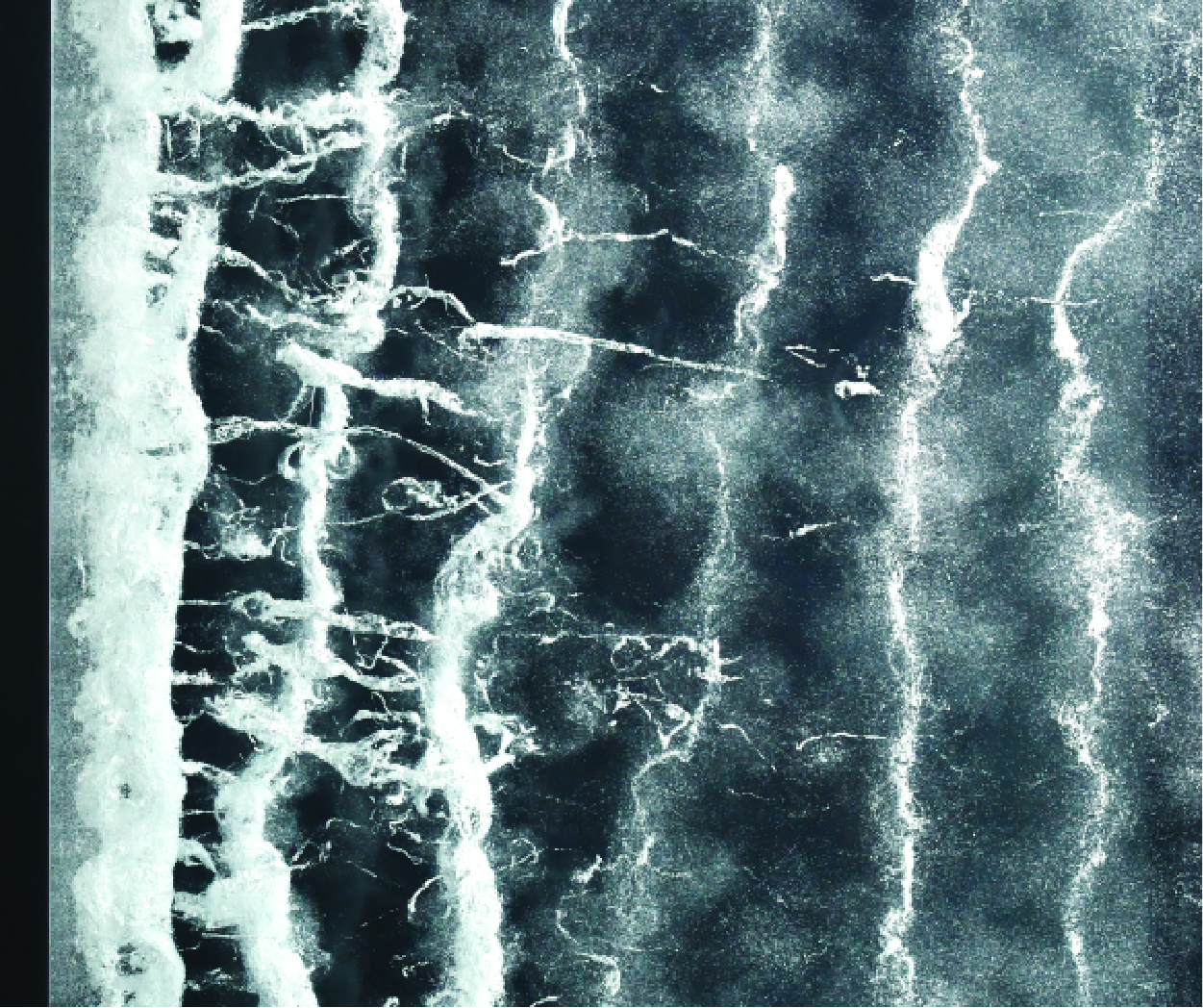 | Allan, E S C; Barbaca, L; Russell, P S; Venning, J A; Pearce, B W; Brandner, P A Cavitation nucleation dynamics in structured turbulence Journal Article Journal of Fluid Mechanics, 1011 , pp. R4, 2025, ISSN: 0022-1120. @article{Allan2025, title = {Cavitation nucleation dynamics in structured turbulence}, author = {E S C Allan and L Barbaca and P S Russell and J A Venning and B W Pearce and P A Brandner}, url = {https://jamesvenning.net/wp-content/uploads/2025/05/cavitation_nucleation_dynamics_in_structured_turbulence.pdf}, doi = {10.1017/jfm.2025.182}, issn = {0022-1120}, year = {2025}, date = {2025-01-01}, journal = {Journal of Fluid Mechanics}, volume = {1011}, pages = {R4}, abstract = { The effect of nucleation on cavitation inception in a high-Reynolds-number von Kármán wake from a bluff two-dimensional hydrofoil is studied experimentally in a variable pressure water tunnel. Nucleation effects are studied by seeding the flow with sparse monodisperse nuclei populations, with the critical pressure nominally equal to vapour pressure. The injected nuclei population and incipient cavitation events were imaged simultaneously using high-speed cameras to precisely quantify the number of activated nuclei of the total available. Three-dimensional spatial characterisation (orientation and location) of the incipient structures is obtained using two high-speed cameras mounted to the side and below the tunnel test section. Inception was observed predominantly in the stretched cores of secondary structures, with a negligible proportion of events occurring in the primary vortices. A broad peak in the vertical angle distribution is observed about the streamwise axis; however, events at all angles are seen. A symmetric distribution was observed for the horizontal angle, with a dominant orientation keywords = {}, pubstate = {published}, tppubtype = {article} } <p> The effect of nucleation on cavitation inception in a high-Reynolds-number von Kármán wake from a bluff two-dimensional hydrofoil is studied experimentally in a variable pressure water tunnel. Nucleation effects are studied by seeding the flow with sparse monodisperse nuclei populations, with the critical pressure nominally equal to vapour pressure. The injected nuclei population and incipient cavitation events were imaged simultaneously using high-speed cameras to precisely quantify the number of activated nuclei of the total available. Three-dimensional spatial characterisation (orientation and location) of the incipient structures is obtained using two high-speed cameras mounted to the side and below the tunnel test section. Inception was observed predominantly in the stretched cores of secondary structures, with a negligible proportion of events occurring in the primary vortices. A broad peak in the vertical angle distribution is observed about the streamwise axis; however, events at all angles are seen. A symmetric distribution was observed for the horizontal angle, with a dominant orientation <inline-formula> <alternatives> <inline-graphic href="S002211202500182X_inline1.png" mime-subtype="png"/> <tex-math>$45^circ $</tex-math> </alternatives> </inline-formula> from the free-stream direction. The majority of events occur at approximately one hydrofoil thickness downstream of the hydrofoil trailing edge, with a bimodal symmetric distribution about the hydrofoil vertical centre plane. Nuclei activation rate is determined from the acoustic measurements, and was found to be proportional to the number of the injected nuclei. A power law increase in activation rate was observed following a decrease in cavitation number and an increase in Reynolds number. The nuclei activation rate was of the order of <inline-formula> <alternatives> <inline-graphic href="S002211202500182X_inline2.png" mime-subtype="png"/> <tex-math>$0.1-10 , mathrm s^-1$</tex-math> </alternatives> </inline-formula> , which combined with seeding rates of the orderof <inline-formula> <alternatives> <inline-graphic href="S002211202500182X_inline3.png" mime-subtype="png"/> <tex-math>$100-1000 , mathrm s^-1$</tex-math> </alternatives> </inline-formula> reveals inception to be a rare occurrence (0.001 %–10 % of nuclei being activated), requiring the confluence of two unlikely events, the occurrence of a subvapour pressure vortex core with capture of a sufficiently weak nuclei. The presented study provides new insights into the physics of cavitation nucleation and inception and provides a comprehensive dataset for development of computational models. </p> |
 | Russell, Patrick S; Barbaca, Luka; Venning, James A; Pearce, Bryce W; Brandner, Paul A Acoustic Measurements of Cavitation and Inception in Tip Leakage Flow Book Chapter Flinovia—Flow Induced Noise and Vibration Issues and Aspects—IV, pp. 223-239, Springer Nature Switzerland, 2025. BibTeX | Links: @inbook{Russell2025, title = {Acoustic Measurements of Cavitation and Inception in Tip Leakage Flow}, author = {Patrick S Russell and Luka Barbaca and James A Venning and Bryce W Pearce and Paul A Brandner}, url = {https://jamesvenning.net/wp-content/uploads/2025/05/Russell-etal-Flinovia2023.pdf}, doi = {10.1007/978-3-031-73935-4_12}, year = {2025}, date = {2025-01-01}, booktitle = {Flinovia—Flow Induced Noise and Vibration Issues and Aspects—IV}, pages = {223-239}, publisher = {Springer Nature Switzerland}, keywords = {}, pubstate = {published}, tppubtype = {inbook} } |
2024 |
|
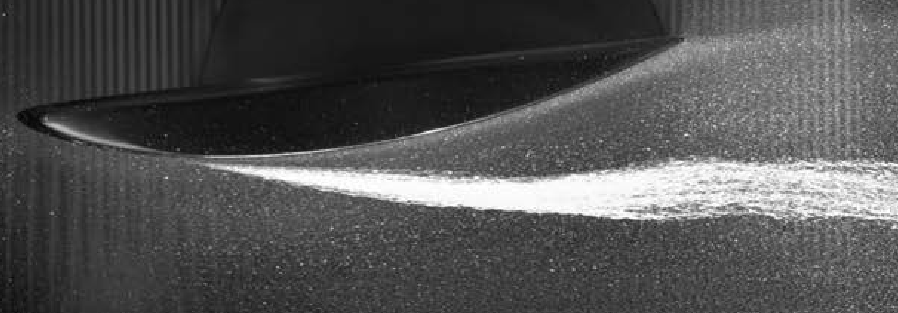 | Russell, P S; Takahashi, K; Barbaca, L; Venning, J A; Pearce, B W; Brandner, P A The influence of boundary-layer thickness on incipient and developed cavitation in tip-leakage flow Inproceedings 35th Symposium of Naval Hydrodynamics, 2024. BibTeX | Links: @inproceedings{Russell2024, title = {The influence of boundary-layer thickness on incipient and developed cavitation in tip-leakage flow}, author = {P S Russell and K Takahashi and L Barbaca and J A Venning and B W Pearce and P A Brandner}, url = {https://jamesvenning.net/wp-content/uploads/2025/05/2024-SNH-35th-Russell_et-al-45_paper.pdf}, year = {2024}, date = {2024-01-01}, booktitle = {35th Symposium of Naval Hydrodynamics}, keywords = {}, pubstate = {published}, tppubtype = {inproceedings} } |
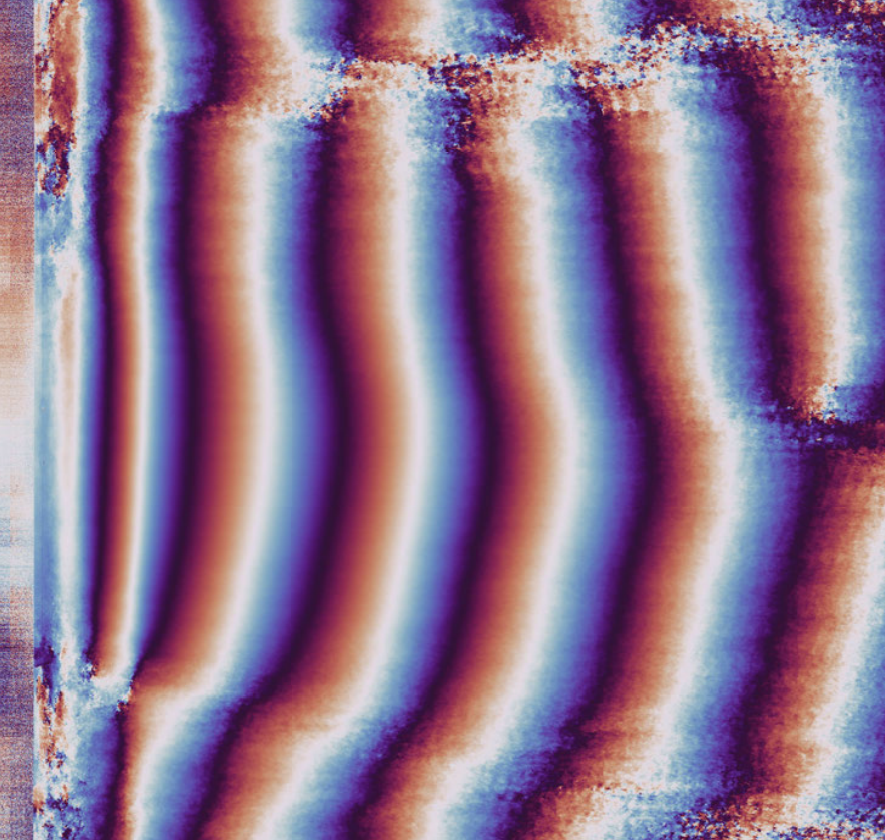 | Venning, James; Allan, Elizabeth; Pearce, Bryce; Russell, Patrick; Barbaca, Luka; Brandner, Paul Scalar-image based decomposition technique for cavitating flows. Inproceedings Australasian Fluid Mechanics Society (AFMS), 2024. BibTeX | Links: @inproceedings{james_venning_2024_14213797, title = {Scalar-image based decomposition technique for cavitating flows.}, author = {James Venning and Elizabeth Allan and Bryce Pearce and Patrick Russell and Luka Barbaca and Paul Brandner}, url = {https://jamesvenning.net/wp-content/uploads/2025/05/AFMC2024_listed_paper_375-1.pdf}, doi = {10.5281/zenodo.14213797}, year = {2024}, date = {2024-01-01}, publisher = {Australasian Fluid Mechanics Society (AFMS)}, keywords = {}, pubstate = {published}, tppubtype = {inproceedings} } |
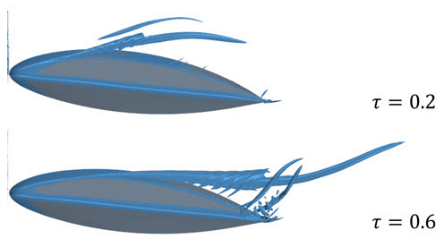 | Takahashi, Kenshiro; Russell, Patrick S; Barbaca, Luka; Pearce, Bryce W; Venning, James A; Brandner, Paul A Numerical study on the influence of boundary-layer thickness on tip-leakage flow for a hydrofoil Inproceedings Proceedings of the 24th Australasian Fluid Mechanics Conference (AFMC), pp. 2024-378, 2024. @inproceedings{Takahashi2024, title = {Numerical study on the influence of boundary-layer thickness on tip-leakage flow for a hydrofoil}, author = {Kenshiro Takahashi and Patrick S Russell and Luka Barbaca and Bryce W Pearce and James A Venning and Paul A Brandner}, url = {https://jamesvenning.net/wp-content/uploads/2025/05/AFMC2024_listed_paper_378.pdf}, doi = {10.5281/zenodo.14213777}, year = {2024}, date = {2024-01-01}, booktitle = {Proceedings of the 24th Australasian Fluid Mechanics Conference (AFMC)}, pages = {2024-378}, abstract = {This study numerically analyses the influence of boundary layer (BL) thickness on the tip-leakage flow for a stationary hydrofoil, presenting the effectiveness of computational predictions. The commercially available computational fluid dynamics (CFD) package Simcenter STAR-CCM+ 2302, which employs a finite-volume method solver, was adopted for the simulations. The k−ω shear stress transport (SST) turbulence model was adopted, and steady simulations were performed to evolve the computations. The distinct BL thicknesses were simulated by adjusting the boundary condition on the inlet of the computational domain. The computed tra-jectories of the tip-leakage vortex (TLV) agreed with those obtained in the experiment (Russell et al., 2024). The leakage flow (transverse flow in the tip clearance) became more significant with decreasing the tip gap, supporting the shift of the TLV away the hydrofoil suction face. The incipient cavitation numbers predicted with CFD for the thicker BL (δ 99 = 70 mm) were smaller than those for the thinner BL (δ 99 = 30 mm), which was consistent with the decreased cavitation event rates with increasing BL thickness reported in the experiment. A high turbulence region extended downwards for the thicker BL, and more significant interactions of the TLV with the BL flow yielded. The higher ambient turbulence and interactions with the BL flow induced fluctuations of the TLV trajectories for the thicker BL and increased the pressure near the vortex core due to the interruption of the TLV coherence.}, keywords = {}, pubstate = {published}, tppubtype = {inproceedings} } This study numerically analyses the influence of boundary layer (BL) thickness on the tip-leakage flow for a stationary hydrofoil, presenting the effectiveness of computational predictions. The commercially available computational fluid dynamics (CFD) package Simcenter STAR-CCM+ 2302, which employs a finite-volume method solver, was adopted for the simulations. The k−ω shear stress transport (SST) turbulence model was adopted, and steady simulations were performed to evolve the computations. The distinct BL thicknesses were simulated by adjusting the boundary condition on the inlet of the computational domain. The computed tra-jectories of the tip-leakage vortex (TLV) agreed with those obtained in the experiment (Russell et al., 2024). The leakage flow (transverse flow in the tip clearance) became more significant with decreasing the tip gap, supporting the shift of the TLV away the hydrofoil suction face. The incipient cavitation numbers predicted with CFD for the thicker BL (δ 99 = 70 mm) were smaller than those for the thinner BL (δ 99 = 30 mm), which was consistent with the decreased cavitation event rates with increasing BL thickness reported in the experiment. A high turbulence region extended downwards for the thicker BL, and more significant interactions of the TLV with the BL flow yielded. The higher ambient turbulence and interactions with the BL flow induced fluctuations of the TLV trajectories for the thicker BL and increased the pressure near the vortex core due to the interruption of the TLV coherence. |
2023 |
|
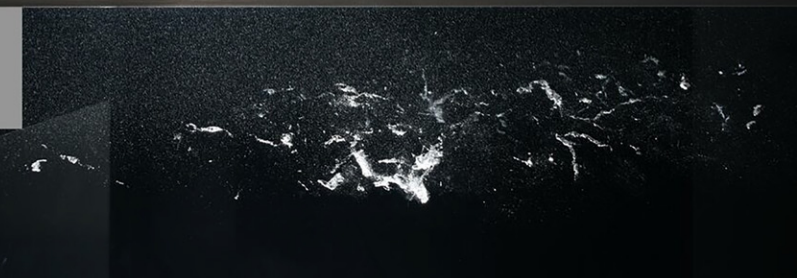 | Allan, E S C; Barbaca, L; Venning, J A; Russell, P S; Pearce, B W; Brandner, P A Nucleation and cavitation inception in high Reynolds number shear layers Journal Article Physics of Fluids, 35 , 2023, ISSN: 10897666. @article{Allan2023a, title = {Nucleation and cavitation inception in high Reynolds number shear layers}, author = {E S C Allan and L Barbaca and J A Venning and P S Russell and B W Pearce and P A Brandner}, url = {https://jamesvenning.net/wp-content/uploads/2023/08/013317_1_online.pdf}, doi = {10.1063/5.0132054}, issn = {10897666}, year = {2023}, date = {2023-01-01}, journal = {Physics of Fluids}, volume = {35}, publisher = {AIP Publishing LLC}, abstract = {The influence of nucleation on cavitation inception in a high Reynolds number shear layer in the wake of a backward-facing step was experimentally investigated in a water tunnel. The flow was investigated for two nuclei populations: the one naturally occurring in the water and for the water artificially seeded with monodisperse nuclei. Incipient events were observed to form in stretched quasi-streamwise vortices. The collapse of an incipient cavity resulted in a microbubble cloud dispersed into the shear layer and the step re-circulation zone. These microbubbles, generally larger than those naturally occurring in the water, act as preferential sites for re-nucleation, triggering the formation of developed cavitation. This phenomenon rendered statistical characterization of cavitation inception impractical for the natural nuclei population. The re-nucleation issue was addressed by seeding the flow with a population of large monodisperse nuclei, with a critical pressure higher than that of cavitation products. Spatial distribution of the nuclei within the seeded plume was characterized using a volumetric measurement based on Mie-scattering imaging. The ability to discern individual incipient events enabled examination of the effect of cavitation number and the nuclei injection rate on the inception event rate. The event rate was found to follow a power law with cavitation number and vary linearly with the injection rate. Mapping of spatial distribution of cavitation susceptibility was obtained by combining the spatial distributions of incipient events and nuclei concentration. The current work provides a valuable dataset for the development of computational tools for modeling of cavitation inception in nucleated flows.}, keywords = {}, pubstate = {published}, tppubtype = {article} } The influence of nucleation on cavitation inception in a high Reynolds number shear layer in the wake of a backward-facing step was experimentally investigated in a water tunnel. The flow was investigated for two nuclei populations: the one naturally occurring in the water and for the water artificially seeded with monodisperse nuclei. Incipient events were observed to form in stretched quasi-streamwise vortices. The collapse of an incipient cavity resulted in a microbubble cloud dispersed into the shear layer and the step re-circulation zone. These microbubbles, generally larger than those naturally occurring in the water, act as preferential sites for re-nucleation, triggering the formation of developed cavitation. This phenomenon rendered statistical characterization of cavitation inception impractical for the natural nuclei population. The re-nucleation issue was addressed by seeding the flow with a population of large monodisperse nuclei, with a critical pressure higher than that of cavitation products. Spatial distribution of the nuclei within the seeded plume was characterized using a volumetric measurement based on Mie-scattering imaging. The ability to discern individual incipient events enabled examination of the effect of cavitation number and the nuclei injection rate on the inception event rate. The event rate was found to follow a power law with cavitation number and vary linearly with the injection rate. Mapping of spatial distribution of cavitation susceptibility was obtained by combining the spatial distributions of incipient events and nuclei concentration. The current work provides a valuable dataset for the development of computational tools for modeling of cavitation inception in nucleated flows. |
 | Russell, P S; Barbaca, L; Venning, J A; Pearce, B W; Brandner, P A Influence of nucleation on cavitation inception in tip leakage flows Journal Article Physics of Fluids, 35 , 2023, ISSN: 10897666. @article{Russell2023a, title = {Influence of nucleation on cavitation inception in tip leakage flows}, author = {P S Russell and L Barbaca and J A Venning and B W Pearce and P A Brandner}, url = {https://jamesvenning.net/wp-content/uploads/2023/08/013341_1_online.pdf}, doi = {10.1063/5.0132034}, issn = {10897666}, year = {2023}, date = {2023-01-01}, journal = {Physics of Fluids}, volume = {35}, publisher = {AIP Publishing LLC}, abstract = {Cavitation in a tip leakage flow is experimentally investigated in a cavitation tunnel using a stationary hydrofoil analogy. The experiments were performed for different tip clearances (τ = gap height / maximum profile thickness) and hydrofoil incidences (α). The chord-based Reynolds number remained fixed at R e = 3 × 10 6. The influence of nucleation on both inception and developed cavitation is evaluated by performing tests with two populations of freestream nuclei: a low concentration with strong critical tensions for activation and a high concentration with weak critical tensions. These populations represent the extremes that would be expected in practical tip leakage flows. Cavitation was characterized using high-speed imaging and acoustic measurements. Following a survey of developed cavitation topology for a range τ and α values, α = 6 ° was selected for further investigation of cavitation inception as it demonstrated a rich variety of physical processes. From the acoustic measurements, the worst performance in terms of cavitation inception was observed at an intermediate gap height of around τ = 0.6 - 0.8 for the "strong water"case. Broadly, cavitation and inception is intermittent when nuclei are sparse, becoming continuous as additional nuclei are introduced. While a continuous cavity in the seeded flow resulted in a higher baseline acoustic signature, sparse populations allow the leakage vortex to sustain tension, which can result in extremely loud incipient events. Optimization of gap height will, therefore, depend on the expected nuclei population during operation.}, keywords = {}, pubstate = {published}, tppubtype = {article} } Cavitation in a tip leakage flow is experimentally investigated in a cavitation tunnel using a stationary hydrofoil analogy. The experiments were performed for different tip clearances (τ = gap height / maximum profile thickness) and hydrofoil incidences (α). The chord-based Reynolds number remained fixed at R e = 3 × 10 6. The influence of nucleation on both inception and developed cavitation is evaluated by performing tests with two populations of freestream nuclei: a low concentration with strong critical tensions for activation and a high concentration with weak critical tensions. These populations represent the extremes that would be expected in practical tip leakage flows. Cavitation was characterized using high-speed imaging and acoustic measurements. Following a survey of developed cavitation topology for a range τ and α values, α = 6 ° was selected for further investigation of cavitation inception as it demonstrated a rich variety of physical processes. From the acoustic measurements, the worst performance in terms of cavitation inception was observed at an intermediate gap height of around τ = 0.6 - 0.8 for the "strong water"case. Broadly, cavitation and inception is intermittent when nuclei are sparse, becoming continuous as additional nuclei are introduced. While a continuous cavity in the seeded flow resulted in a higher baseline acoustic signature, sparse populations allow the leakage vortex to sustain tension, which can result in extremely loud incipient events. Optimization of gap height will, therefore, depend on the expected nuclei population during operation. |
2022 |
|
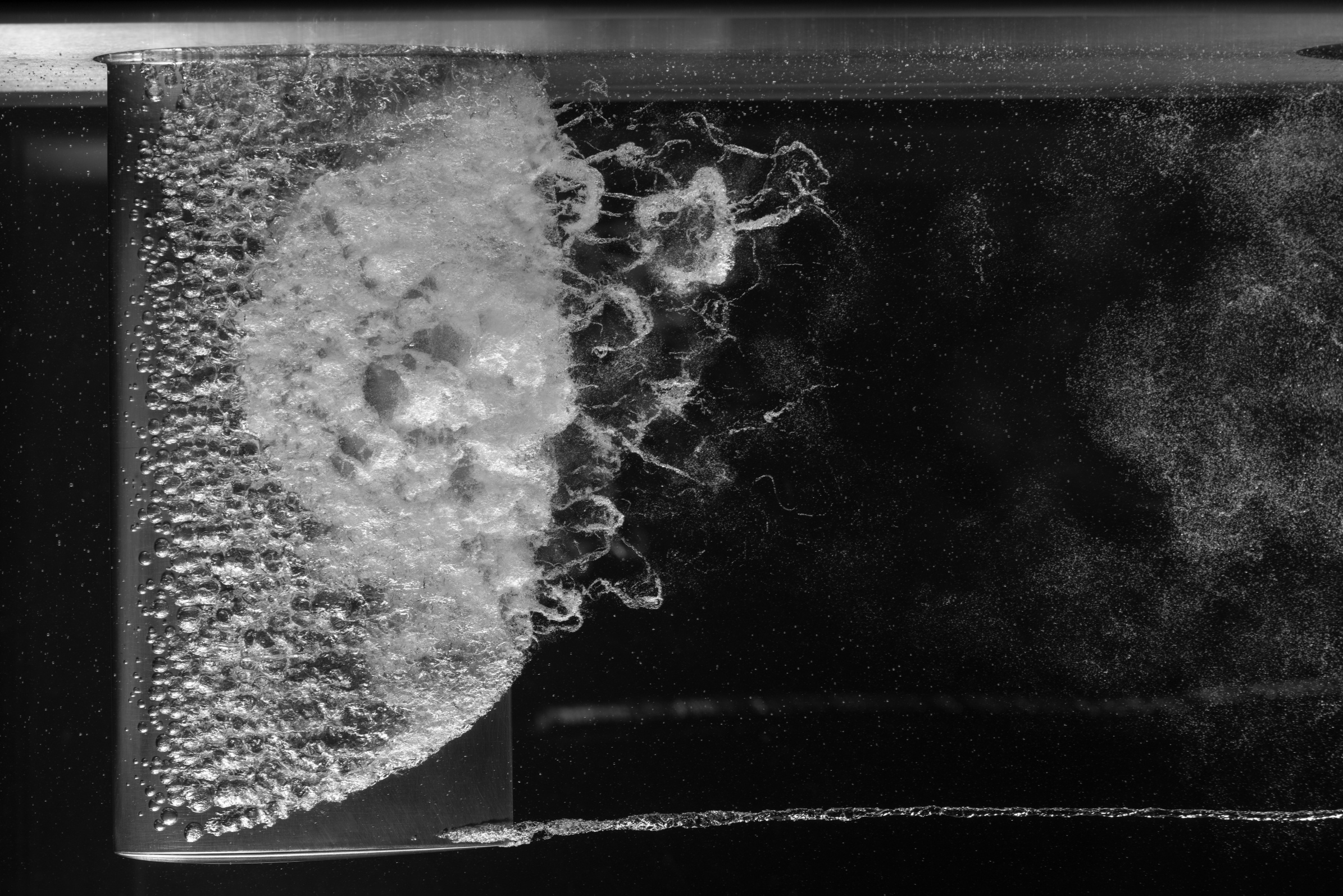 | Venning, James A; Pearce, Bryce W; Brandner, Paul A Nucleation effects on cloud cavitation about a hydrofoil Journal Article Journal of Fluid Mechanics, 947 , pp. A1, 2022, ISSN: 0022-1120, 1469-7645. @article{venning_nucleation_2022, title = {Nucleation effects on cloud cavitation about a hydrofoil}, author = {James A Venning and Bryce W Pearce and Paul A Brandner}, url = {https://jamesvenning.net/wp-content/uploads/2022/09/JFM_nucleation-effects-on-cloud-cavitation-about-a-hydrofoil.pdf}, doi = {10.1017/jfm.2022.535}, issn = {0022-1120, 1469-7645}, year = {2022}, date = {2022-09-01}, urldate = {2022-09-12}, journal = {Journal of Fluid Mechanics}, volume = {947}, pages = {A1}, abstract = {The dynamics of cloud cavitation about a three-dimensional hydrofoil are investigated experimentally in a cavitation tunnel with depleted, sparse and abundant free-stream nuclei populations. A rectangular planform, NACA 0015 hydrofoil was tested at a Reynolds number of 1.4 × 106, an incidence of 6◦ and a range of cavitation numbers from single-phase flow to supercavitation. High-speed photographs of cavitation shedding phenomena were acquired simultaneously with unsteady force measurement to enable identification of cavity shedding modes corresponding to force spectral peaks. The shedding modes were analysed through spectral decomposition of the high-speed movies, revealing different shedding instabilities according to the nuclei content. With no active nuclei, the fundamental shedding mode occurs at a Strouhal number of 0.28 and is defined by large-scale re-entrant jet formation during the growth phase, but shockwave propagation for the collapse phase of the cycle. Harmonic and subharmonic modes also occur due to local tip shedding. For the abundant case, the fundamental shedding is again large-scale but with a much slower growth phase resulting in a frequency of St = 0.15. A harmonic mode forms in this case due to the propagation of two shockwaves; an initial slow propagating wave followed by a second faster wave. The passage of the first wave causes partial condensation leading to lower void fraction and consequent increase in the speed of the second wave along with larger-scale condensation. For a sparsely seeded flow, coherent fluctuations are reduced due to intermittent, disperse nuclei activation and cavity breakup resulting in an optimal condition with maximum reduction in unsteady lift.}, keywords = {}, pubstate = {published}, tppubtype = {article} } The dynamics of cloud cavitation about a three-dimensional hydrofoil are investigated experimentally in a cavitation tunnel with depleted, sparse and abundant free-stream nuclei populations. A rectangular planform, NACA 0015 hydrofoil was tested at a Reynolds number of 1.4 × 106, an incidence of 6◦ and a range of cavitation numbers from single-phase flow to supercavitation. High-speed photographs of cavitation shedding phenomena were acquired simultaneously with unsteady force measurement to enable identification of cavity shedding modes corresponding to force spectral peaks. The shedding modes were analysed through spectral decomposition of the high-speed movies, revealing different shedding instabilities according to the nuclei content. With no active nuclei, the fundamental shedding mode occurs at a Strouhal number of 0.28 and is defined by large-scale re-entrant jet formation during the growth phase, but shockwave propagation for the collapse phase of the cycle. Harmonic and subharmonic modes also occur due to local tip shedding. For the abundant case, the fundamental shedding is again large-scale but with a much slower growth phase resulting in a frequency of St = 0.15. A harmonic mode forms in this case due to the propagation of two shockwaves; an initial slow propagating wave followed by a second faster wave. The passage of the first wave causes partial condensation leading to lower void fraction and consequent increase in the speed of the second wave along with larger-scale condensation. For a sparsely seeded flow, coherent fluctuations are reduced due to intermittent, disperse nuclei activation and cavity breakup resulting in an optimal condition with maximum reduction in unsteady lift. |
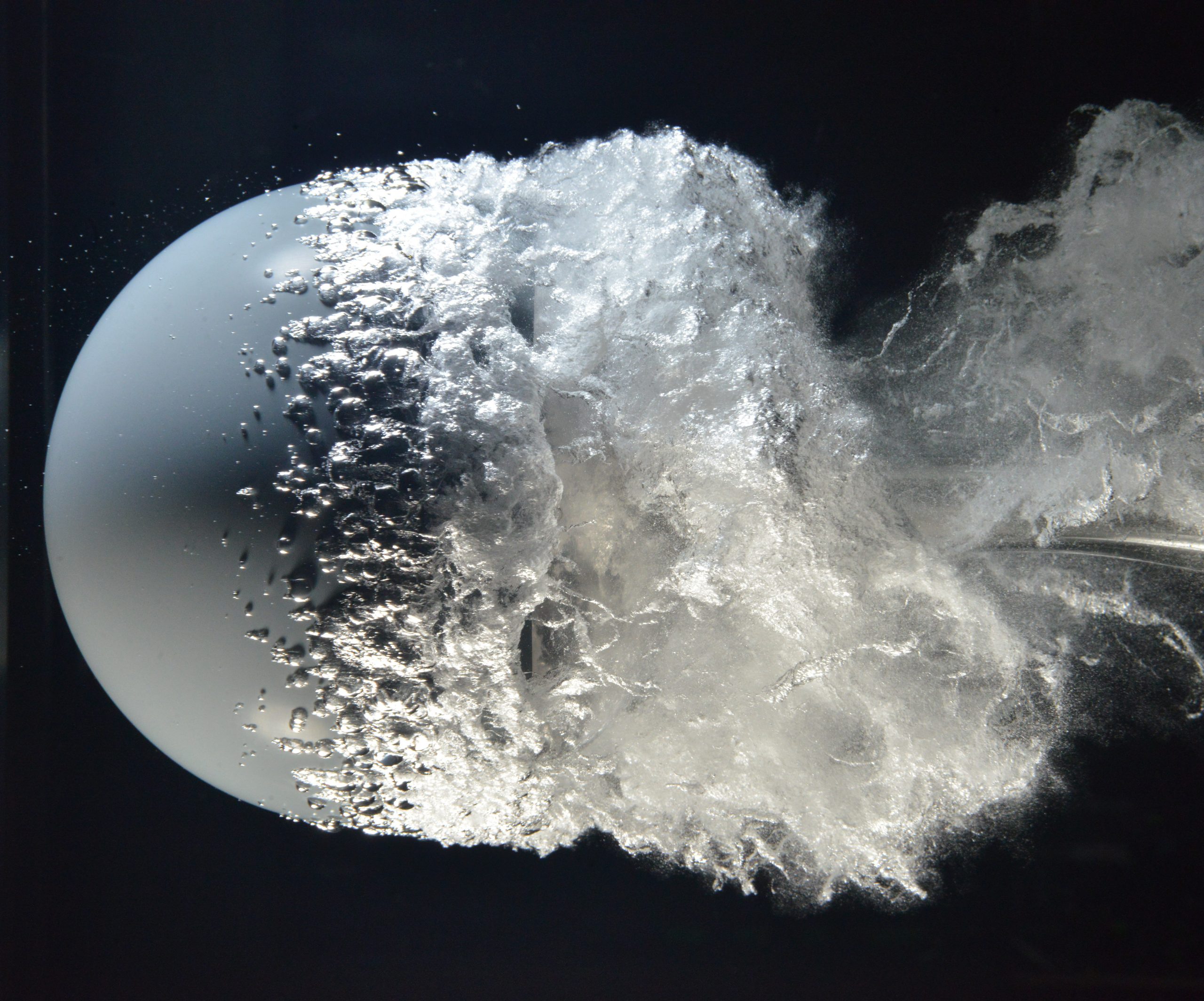 | Brandner, Paul A; Venning, James A; Pearce, Bryce W Nucleation effects on cavitation about a sphere Journal Article Journal of Fluid Mechanics, 946 , pp. A1, 2022, ISSN: 0022-1120, 1469-7645. @article{brandner_nucleation_2022, title = {Nucleation effects on cavitation about a sphere}, author = {Paul A Brandner and James A Venning and Bryce W Pearce}, url = {https://jamesvenning.net/wp-content/uploads/2022/09/JFM_nucleation-effects-on-cavitation-about-a-sphere.pdf}, doi = {10.1017/jfm.2022.511}, issn = {0022-1120, 1469-7645}, year = {2022}, date = {2022-07-01}, urldate = {2022-09-12}, journal = {Journal of Fluid Mechanics}, volume = {946}, pages = {A1}, abstract = {The influence of nucleation on cavitation about a sphere from inception through to supercavitation at a transcritical Reynolds number of 1.5 million is investigated experimentally. Two extreme free-stream nuclei populations, deplete and abundant, were investigated. Unsteady surface pressures from two sensors on opposing sides of the sphere were acquired simultaneous with high-resolution high-speed photography at cavitation numbers between 1.0 and 0.3. High-resolution spectrograms derived from these measurements reveal principally bi-modal shedding in attached and detached regimes. Correlations between unsteady pressure measurements show the high modes to be axisymmetric and low modes asymmetric. Modal topology is also discerned from the high-speed imaging. The bi-modal shedding for lower cavitation numbers is driven by coupled re-entrant jet formation and upstream shockwave propagation. The attached regime is shown to have two sub-regimes. For the abundant case, the continuous supply of activated nuclei around the sphere periphery in the first bi-modal regime has the effect of driving the high symmetric mode preferentially over the asymmetric low mode compared with the deplete case. For the first bi-modal regime, frequencies were unaffected by nucleation changes although peak responses were centred at a cavitation number of about 0.8 for the deplete and 0.825 for the abundant. For the second attached regime, where cavity lengths are of the order of the sphere size, changes in nucleation altered frequencies and amplitudes of peak unsteady pressures. For the abundant case, the continuous nuclei supply significantly reduced coherence with modal peak amplitudes reduced by an order compared with the deplete case. Continuous nuclei activation increased the probability of the high mode over the low compared with the deplete case but to a lesser extent than the first regime. Nuclei activations also significantly reduced inter-cavity and cavity durations, but not growth and collapse phases, which increased modal frequencies compared with the deplete case. The second regime asymmetric low mode topology, for both nucleation cases, is shown to be alternate shedding of oblique vortices from diametrically opposing sides of the sphere similar to low Reynolds number shedding about spheres and other axisymmetric bluff bodies in single-phase flows.}, keywords = {}, pubstate = {published}, tppubtype = {article} } The influence of nucleation on cavitation about a sphere from inception through to supercavitation at a transcritical Reynolds number of 1.5 million is investigated experimentally. Two extreme free-stream nuclei populations, deplete and abundant, were investigated. Unsteady surface pressures from two sensors on opposing sides of the sphere were acquired simultaneous with high-resolution high-speed photography at cavitation numbers between 1.0 and 0.3. High-resolution spectrograms derived from these measurements reveal principally bi-modal shedding in attached and detached regimes. Correlations between unsteady pressure measurements show the high modes to be axisymmetric and low modes asymmetric. Modal topology is also discerned from the high-speed imaging. The bi-modal shedding for lower cavitation numbers is driven by coupled re-entrant jet formation and upstream shockwave propagation. The attached regime is shown to have two sub-regimes. For the abundant case, the continuous supply of activated nuclei around the sphere periphery in the first bi-modal regime has the effect of driving the high symmetric mode preferentially over the asymmetric low mode compared with the deplete case. For the first bi-modal regime, frequencies were unaffected by nucleation changes although peak responses were centred at a cavitation number of about 0.8 for the deplete and 0.825 for the abundant. For the second attached regime, where cavity lengths are of the order of the sphere size, changes in nucleation altered frequencies and amplitudes of peak unsteady pressures. For the abundant case, the continuous nuclei supply significantly reduced coherence with modal peak amplitudes reduced by an order compared with the deplete case. Continuous nuclei activation increased the probability of the high mode over the low compared with the deplete case but to a lesser extent than the first regime. Nuclei activations also significantly reduced inter-cavity and cavity durations, but not growth and collapse phases, which increased modal frequencies compared with the deplete case. The second regime asymmetric low mode topology, for both nucleation cases, is shown to be alternate shedding of oblique vortices from diametrically opposing sides of the sphere similar to low Reynolds number shedding about spheres and other axisymmetric bluff bodies in single-phase flows. |
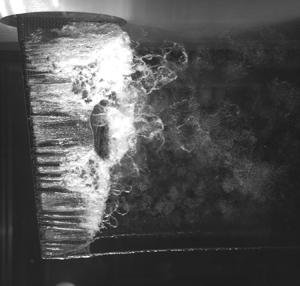 | Young, Yin Lu; Chang, Jasmine C; Smith, Samuel M; Venning, James A; Pearce, Bryce W; Brandner, Paul A The influence of fluid–structure interaction on cloud cavitation about a rigid and a flexible hydrofoil. Part 3 Journal Article Journal of Fluid Mechanics, 934 , pp. 1–46, 2022, ISSN: 0022-1120. @article{Young2022, title = {The influence of fluid–structure interaction on cloud cavitation about a rigid and a flexible hydrofoil. Part 3}, author = {Yin Lu Young and Jasmine C Chang and Samuel M Smith and James A Venning and Bryce W Pearce and Paul A Brandner}, url = {https://jamesvenning.net/wp-content/uploads/2022/01/Young-et-al.-2022-The-influence-of-fluid–structure-interaction-on-cloud-cavitation-about-a-rigid-and-a-flexible-hydrofoil.-Part-3.pdf}, doi = {10.1017/jfm.2021.1017}, issn = {0022-1120}, year = {2022}, date = {2022-01-01}, journal = {Journal of Fluid Mechanics}, volume = {934}, pages = {1--46}, abstract = {Experimental studies of the influence of fluid–structure interaction on cloud cavitation about a stiff stainless steel (SS) and a flexible composite (CF) hydrofoil have been presented in Parts I (Smith et al. , J. Fluid Mech. , vol. 896, 2020 a , p. A1) and II (Smith et al. , J. Fluid Mech. , vol. 897, 2020 b , p. A28). This work further analyses the data and complements the measurements with reduced-order model predictions to explain the complex response. A two degrees-of-freedom steady-state model is used to explain why the tip bending and twisting deformations are much higher for the CF hydrofoil, while the hydrodynamic load coefficients are very similar. A one degree-of-freedom dynamic model, which considers the spanwise bending deflection only, is used to capture the dynamic response of both hydrofoils. Peaks in the frequency response spectrum are observed at the re-entrant jet-driven and shock-wave-driven cavity shedding frequencies, system bending frequency and heterodyne frequencies caused by the mixing of the two cavity shedding frequencies. The predictions capture the increase of the mean system bending frequency and wider bandwidth of frequency modulation with decreasing cavitation number. The results show that, in general, the amplitude of the deformation fluctuation is higher, but the amplitude of the load fluctuation is lower for the CF hydrofoil compared with the SS hydrofoil. Significant dynamic load amplification is observed at subharmonic lock-in when the shock-wave-driven cavity shedding frequency matches with the nearest subharmonic of the system bending frequency of the CF hydrofoil. Both measurements and predictions show an absence of dynamic load amplification at primary lock-in because of the low intensity of cavity load fluctuations with high cavitation number.}, keywords = {}, pubstate = {published}, tppubtype = {article} } Experimental studies of the influence of fluid–structure interaction on cloud cavitation about a stiff stainless steel (SS) and a flexible composite (CF) hydrofoil have been presented in Parts I (Smith et al. , J. Fluid Mech. , vol. 896, 2020 a , p. A1) and II (Smith et al. , J. Fluid Mech. , vol. 897, 2020 b , p. A28). This work further analyses the data and complements the measurements with reduced-order model predictions to explain the complex response. A two degrees-of-freedom steady-state model is used to explain why the tip bending and twisting deformations are much higher for the CF hydrofoil, while the hydrodynamic load coefficients are very similar. A one degree-of-freedom dynamic model, which considers the spanwise bending deflection only, is used to capture the dynamic response of both hydrofoils. Peaks in the frequency response spectrum are observed at the re-entrant jet-driven and shock-wave-driven cavity shedding frequencies, system bending frequency and heterodyne frequencies caused by the mixing of the two cavity shedding frequencies. The predictions capture the increase of the mean system bending frequency and wider bandwidth of frequency modulation with decreasing cavitation number. The results show that, in general, the amplitude of the deformation fluctuation is higher, but the amplitude of the load fluctuation is lower for the CF hydrofoil compared with the SS hydrofoil. Significant dynamic load amplification is observed at subharmonic lock-in when the shock-wave-driven cavity shedding frequency matches with the nearest subharmonic of the system bending frequency of the CF hydrofoil. Both measurements and predictions show an absence of dynamic load amplification at primary lock-in because of the low intensity of cavity load fluctuations with high cavitation number. |
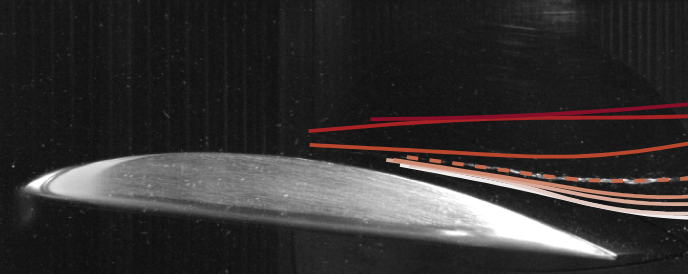 | Russell, Patrick; Barbaca, Luka; Venning, James; Pearce, Bryce; Brandner, Paul The effect of nuclei and gap height on cavitation in tip leakage flow Inproceedings 23rd Australasian Fluid Mechanics Conference, pp. 0-7, 2022. BibTeX | Links: @inproceedings{Russell2022a, title = {The effect of nuclei and gap height on cavitation in tip leakage flow}, author = {Patrick Russell and Luka Barbaca and James Venning and Bryce Pearce and Paul Brandner}, url = {https://jamesvenning.net/wp-content/uploads/2023/08/afmc23-Russell_et_al_TipLeakage_P129.pdf}, year = {2022}, date = {2022-01-01}, booktitle = {23rd Australasian Fluid Mechanics Conference}, pages = {0-7}, keywords = {}, pubstate = {published}, tppubtype = {inproceedings} } |
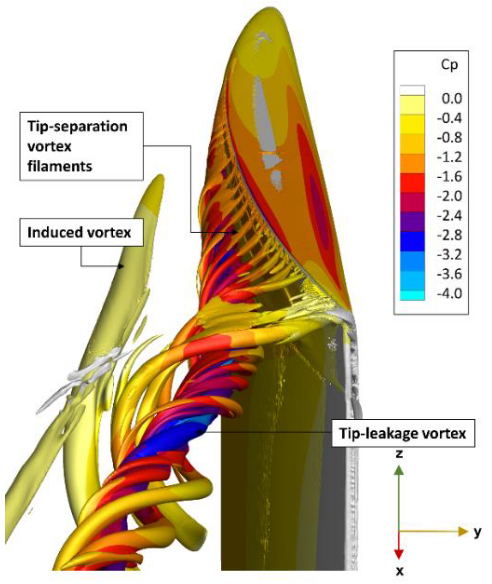 | Jin, Y; Pook, D A; Venning, J A; Russell, P S; Barbaca, L; Pearce, B W; Brandner, P A; Group, Technology Computational Study of Tip-Leakage Flow Around a Static Hydrofoil Inproceedings 23rd Australasian Fluid Mechanics Conference, 2022. BibTeX | Links: @inproceedings{Jin2022, title = {Computational Study of Tip-Leakage Flow Around a Static Hydrofoil}, author = {Y Jin and D A Pook and J A Venning and P S Russell and L Barbaca and B W Pearce and P A Brandner and Technology Group}, url = {https://jamesvenning.net/wp-content/uploads/2023/08/afmc23-Jin_et_al_CompTipLeakage_P48.pdf}, year = {2022}, date = {2022-01-01}, booktitle = {23rd Australasian Fluid Mechanics Conference}, keywords = {}, pubstate = {published}, tppubtype = {inproceedings} } |
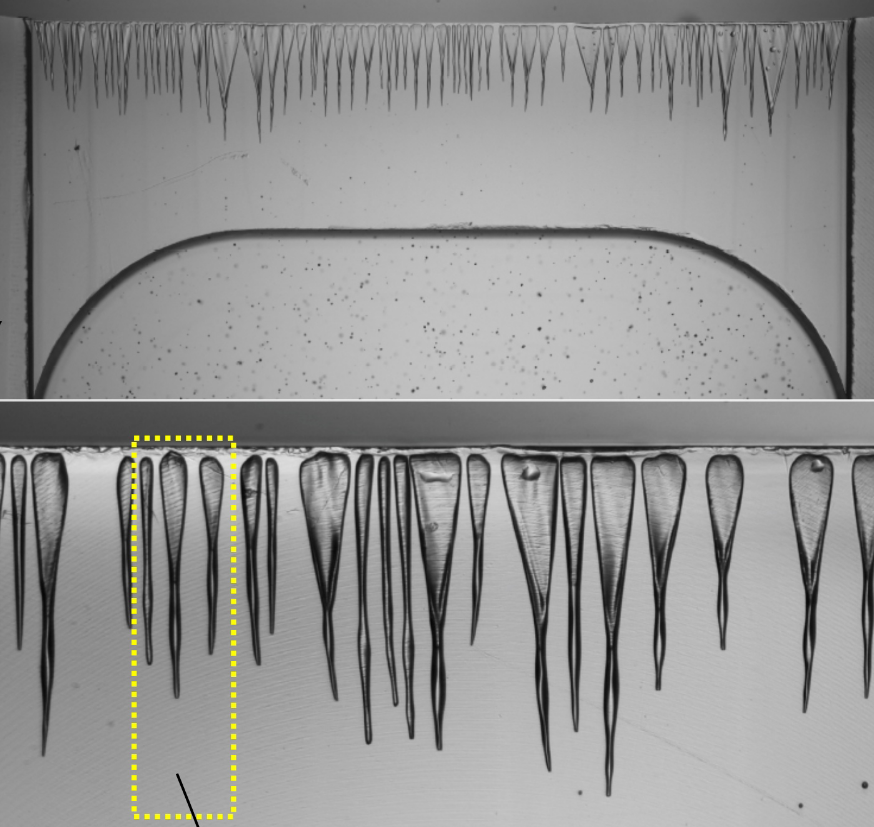 | Cook, Sienna; Barbaca, Luka; Russell, Patrick; Venning, James; Pearce, Bryce; Brandner, Paul Microbubble Generation via Combined Saffman-Taylor and Plateau-Rayleigh Instabilities Inproceedings 23rd Australasian Fluid Mechanics Conference, pp. 1-8, 2022. BibTeX | Links: @inproceedings{Cook2022, title = {Microbubble Generation via Combined Saffman-Taylor and Plateau-Rayleigh Instabilities}, author = {Sienna Cook and Luka Barbaca and Patrick Russell and James Venning and Bryce Pearce and Paul Brandner}, url = {https://jamesvenning.net/wp-content/uploads/2023/08/afmc23-Cook_et_al_PlaneShearLayer_final_P273.pdf}, year = {2022}, date = {2022-01-01}, booktitle = {23rd Australasian Fluid Mechanics Conference}, pages = {1-8}, keywords = {}, pubstate = {published}, tppubtype = {inproceedings} } |
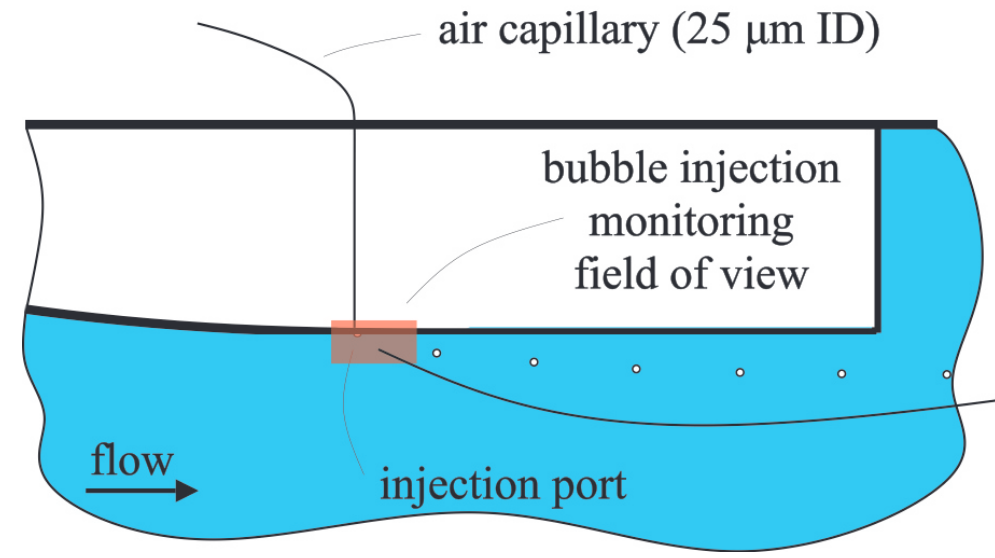 | Allan, Elizabeth S C; Barbaca, Luka; Russell, Patrick S; Venning, James A; Pearce, Bryce W Measurement of Cavitation Nuclei Dispersion in Hydrodynamic Facilities Inproceedings 23rd Australasian Fluid Mechanics Conference, 2022. BibTeX | Links: @inproceedings{Allan2022, title = {Measurement of Cavitation Nuclei Dispersion in Hydrodynamic Facilities}, author = {Elizabeth S C Allan and Luka Barbaca and Patrick S Russell and James A Venning and Bryce W Pearce}, url = {https://jamesvenning.net/wp-content/uploads/2023/08/afmc23-Allan_et_al_MSI_final_P274.pdf}, year = {2022}, date = {2022-01-01}, booktitle = {23rd Australasian Fluid Mechanics Conference}, keywords = {}, pubstate = {published}, tppubtype = {inproceedings} } |
 | Ailwood, Aaron; Venning, James A; Barbaca, Luka; Russell, Patrick S; Pearce, Bryce W; Brandner, Paul A Scaling of Microbubble Generation in a T-junction Inproceedings 23rd Australasian Fluid Mechanics Conference, 2022. BibTeX | Links: @inproceedings{Ailwood2022, title = {Scaling of Microbubble Generation in a T-junction}, author = {Aaron Ailwood and James A Venning and Luka Barbaca and Patrick S Russell and Bryce W Pearce and Paul A Brandner}, url = {https://jamesvenning.net/wp-content/uploads/2023/08/afmc23-Ailwood_et_al_TJunction_final_P255.pdf}, year = {2022}, date = {2022-01-01}, booktitle = {23rd Australasian Fluid Mechanics Conference}, keywords = {}, pubstate = {published}, tppubtype = {inproceedings} } |
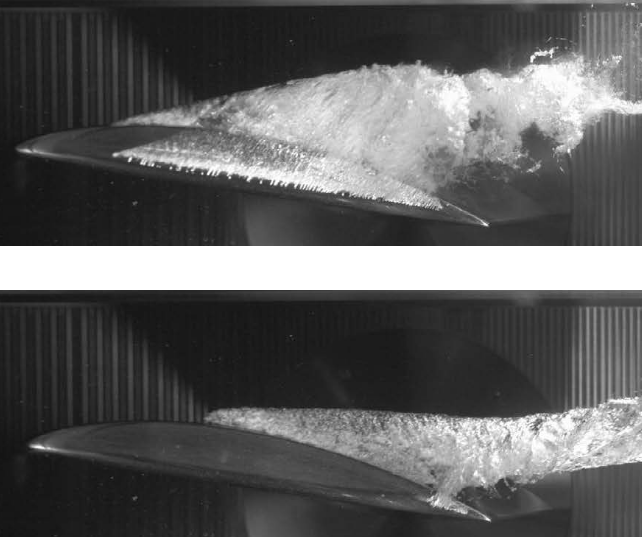 | Russell, P S; Barbaca, L; Venning, J A; Pearce, B W; Brandner, P A The influence of nucleation on cavitation inception in tip-leakage flows Inproceedings 34th Symposium on Naval Hydrodynamics, 2022. BibTeX | Links: @inproceedings{Russell2022b, title = {The influence of nucleation on cavitation inception in tip-leakage flows}, author = {P S Russell and L Barbaca and J A Venning and B W Pearce and P A Brandner}, url = {https://jamesvenning.net/wp-content/uploads/2025/05/2022-SNH-34th-Russell_et-al-8_paper.pdf}, year = {2022}, date = {2022-01-01}, booktitle = {34th Symposium on Naval Hydrodynamics}, keywords = {}, pubstate = {published}, tppubtype = {inproceedings} } |
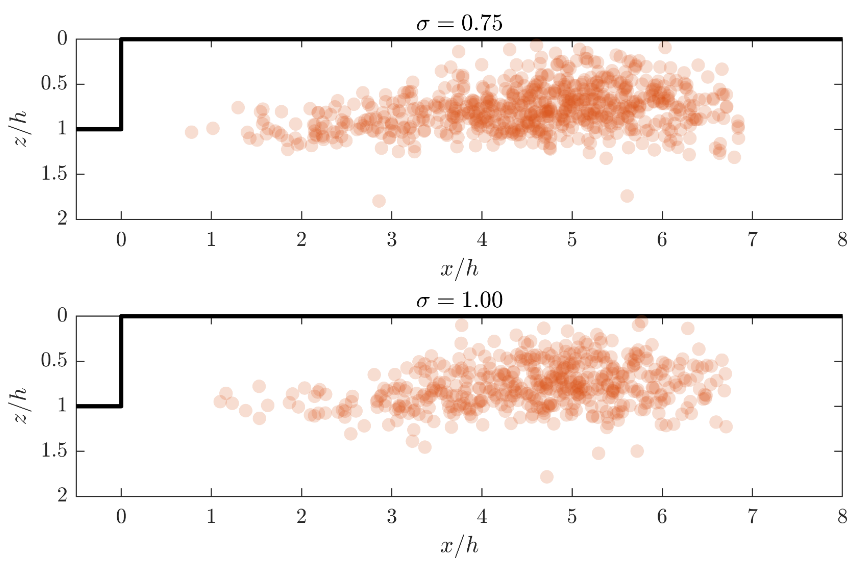 | Allan, E S C; Barbaca, L; Russell, P S; Venning, J A; Pearce, B W; Brandner, P A The influence of nucleation on cavitation inception in turbulent shear layers Inproceedings 34th Symposium on Naval Hydrodynamics, 2022. @inproceedings{Allan2022b, title = {The influence of nucleation on cavitation inception in turbulent shear layers}, author = {E S C Allan and L Barbaca and P S Russell and J A Venning and B W Pearce and P A Brandner}, url = {https://jamesvenning.net/wp-content/uploads/2025/05/2022-SNH-34th-Allan_et-al-92_paper.pdf}, year = {2022}, date = {2022-01-01}, booktitle = {34th Symposium on Naval Hydrodynamics}, abstract = {The influence of nucleation on cavitation inception in a high Reynolds number turbulent shear layer in the wake of a backward facing step was investigated using a controlled nuclei population. The flow was seeded with near monodisperse nuclei through a single injection port upstream of the step. The spatial distribution of the nuclei concentration within the resulting plume was characterized using a volumetric nuclei measurement technique based on Mie-Scattering Imaging. Incipient cavitation events were captured using two high-speed cameras, mounted to the side and below the tunnel test-section, triggered simultaneously with acoustic measurements. Seeding the flow with large nuclei addressed the issue of secondary re-nucleation in the step re-circulation zone and onset of developed cavitation observed for the flow with the natural nuclei population. Ability to discern individual incipient events enabled examination of the effect of cavitation number and the number of injected nuclei on the inception event rate. The event rate was found to follow a power law with cavitation number and to be linear with the injection rate. The inception events were mainly detected within the boundaries of the nuclei plume, however, a considerable number of out of plume events were observed. This was linked to capture of injected nuclei and/or generated cavitation products in the step re-circulation zone and their dispersion across the tunnel span due to flow three dimensionality. This suggests that the use of a more two-dimensional geometry with limited volume of re-circulation to capture and store nuclei might be beneficial. Notwithstanding these issues, mapping of spatial distribution of cavitation susceptibility, obtained by combining the spatial distribution of cavitation events and nuclei concentration, compare favourably with those reported for the same geometry in the literature. The current work provides a valuable dataset for development of computational tools for modelling of cavitation inception in nucleated flows.}, keywords = {}, pubstate = {published}, tppubtype = {inproceedings} } The influence of nucleation on cavitation inception in a high Reynolds number turbulent shear layer in the wake of a backward facing step was investigated using a controlled nuclei population. The flow was seeded with near monodisperse nuclei through a single injection port upstream of the step. The spatial distribution of the nuclei concentration within the resulting plume was characterized using a volumetric nuclei measurement technique based on Mie-Scattering Imaging. Incipient cavitation events were captured using two high-speed cameras, mounted to the side and below the tunnel test-section, triggered simultaneously with acoustic measurements. Seeding the flow with large nuclei addressed the issue of secondary re-nucleation in the step re-circulation zone and onset of developed cavitation observed for the flow with the natural nuclei population. Ability to discern individual incipient events enabled examination of the effect of cavitation number and the number of injected nuclei on the inception event rate. The event rate was found to follow a power law with cavitation number and to be linear with the injection rate. The inception events were mainly detected within the boundaries of the nuclei plume, however, a considerable number of out of plume events were observed. This was linked to capture of injected nuclei and/or generated cavitation products in the step re-circulation zone and their dispersion across the tunnel span due to flow three dimensionality. This suggests that the use of a more two-dimensional geometry with limited volume of re-circulation to capture and store nuclei might be beneficial. Notwithstanding these issues, mapping of spatial distribution of cavitation susceptibility, obtained by combining the spatial distribution of cavitation events and nuclei concentration, compare favourably with those reported for the same geometry in the literature. The current work provides a valuable dataset for development of computational tools for modelling of cavitation inception in nucleated flows. |
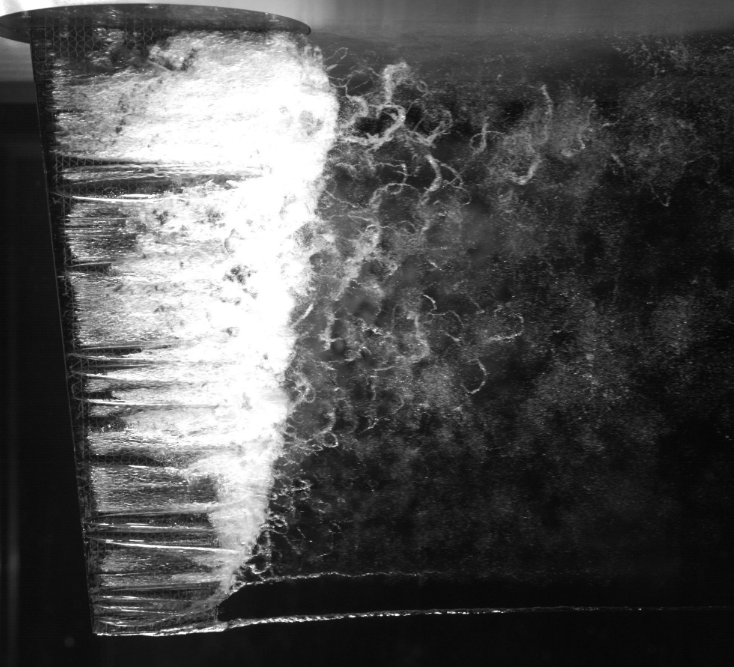 | Chang, J C; Smith, S M; Venning, J A; Pearce, B W; Brandner, P A; Young, Y L Data-Driven Model of the Response of Flexible Hydrofoils in Cloud Cavitation Inproceedings 34th Symposium on Naval Hydrodynamics, 2022. @inproceedings{Chang2022, title = {Data-Driven Model of the Response of Flexible Hydrofoils in Cloud Cavitation}, author = {J C Chang and S M Smith and J A Venning and B W Pearce and P A Brandner and Y L Young}, url = {https://jamesvenning.net/wp-content/uploads/2025/05/165_snh_proceedings-Jasmine-Chang.pdf}, year = {2022}, date = {2022-01-01}, booktitle = {34th Symposium on Naval Hydrodynamics}, abstract = {The objective of this work is to discover the equations that govern the response of stiff and flexible hydrofoils in cloud cavitation via the usage of Sparse Identification of Nonlinear Dynamics (SINDy). Cavitation is a special form of separated multiphase flow relevant for a diverse range of hydrodynamic lifting bodies such as propellers, flow control surfaces, energy harvesting and energy saving devices that operate at high speeds and/or near the free surface. Since many lifting devices are effectively thin plates or beams subject to high loading, flow-induced deformations and vibrations may occur. The deformations modify the surrounding flow, changing the cavity dynamics and resulting response. In this work, we employ SINDy to discover the coefficients of the nonlinear dynamical system based on experimental data for a stiff stainless steel (SS) and a flexible composite (CF) hydrofoil in cloud cavitation collected at the Australian Maritime College in the Cavitation Research Laboratory water tunnel. We aim to determine the variation of fluid added mass and damping coefficients with the effective cavitation parameter, as well as the resulting fluctuating lift coefficients due to fluid-structure interaction using SINDy, and compare the coefficients with the physics-based reduced-order model (ROM) of the cloud cavitation response of flexible hydrofoils presented in Young et al. (2022). The results show that in general, while the linear fluid added mass and damping coefficients are approximately the same between the data-driven and physics-based ROM, there were noticeable differences in the trend and magnitude for the nonlinear fluid added mass and damping terms, as well as the rigid hydrofoil cavity forcing terms. Despite these differences, the governing equations with nonlinear damping predicted by SINDy can capture the dominant frequencies of the SS and CF hydrofoils in unsteady cavitating flow. However, the usage of SINDy is limited to the cavitation number range where the intensity of load fluctuations caused by unsteady cloud cavitation is higher than the ambient noise. For this experimental setup, this range is 0.3 ≤ σ ≤ 0.8. Additional data or more accurate numerical modeling would be needed for proper model development and validation. INTRODUCTION Cavitation is a form of separated multiphase flow that commonly occurs on the surface of hydrodynamic lifting surfaces, such as marine propulsors, rudders, energy saving and energy harvesting devices, particularly when the device operates at high speeds and/or near the free surface. Cavitation occurs when the absolute local fluid pressure drops to or slightly below the saturated vapor pressure (Brennen, 1995). The tensile stress that the fluid experiences due to the difference in local pressure and saturated vapor pressure triggers the rupture of the fluid, commonly at voids or small contaminant particles in the fluid, to form vapor bubbles (Brennen, 1995). Sheet cavitation occurs when cavities remain attached to the lifting surface, with a liquid-vapor mixture filling the separated flow region. This work focuses on cloud cavitation, which describes an unsteady or periodic formation, detachment, and collapse of sheet cavities, giving the shed cavities a cloud-like appearance (Brandner et al., 2010).}, keywords = {}, pubstate = {published}, tppubtype = {inproceedings} } The objective of this work is to discover the equations that govern the response of stiff and flexible hydrofoils in cloud cavitation via the usage of Sparse Identification of Nonlinear Dynamics (SINDy). Cavitation is a special form of separated multiphase flow relevant for a diverse range of hydrodynamic lifting bodies such as propellers, flow control surfaces, energy harvesting and energy saving devices that operate at high speeds and/or near the free surface. Since many lifting devices are effectively thin plates or beams subject to high loading, flow-induced deformations and vibrations may occur. The deformations modify the surrounding flow, changing the cavity dynamics and resulting response. In this work, we employ SINDy to discover the coefficients of the nonlinear dynamical system based on experimental data for a stiff stainless steel (SS) and a flexible composite (CF) hydrofoil in cloud cavitation collected at the Australian Maritime College in the Cavitation Research Laboratory water tunnel. We aim to determine the variation of fluid added mass and damping coefficients with the effective cavitation parameter, as well as the resulting fluctuating lift coefficients due to fluid-structure interaction using SINDy, and compare the coefficients with the physics-based reduced-order model (ROM) of the cloud cavitation response of flexible hydrofoils presented in Young et al. (2022). The results show that in general, while the linear fluid added mass and damping coefficients are approximately the same between the data-driven and physics-based ROM, there were noticeable differences in the trend and magnitude for the nonlinear fluid added mass and damping terms, as well as the rigid hydrofoil cavity forcing terms. Despite these differences, the governing equations with nonlinear damping predicted by SINDy can capture the dominant frequencies of the SS and CF hydrofoils in unsteady cavitating flow. However, the usage of SINDy is limited to the cavitation number range where the intensity of load fluctuations caused by unsteady cloud cavitation is higher than the ambient noise. For this experimental setup, this range is 0.3 ≤ σ ≤ 0.8. Additional data or more accurate numerical modeling would be needed for proper model development and validation. INTRODUCTION Cavitation is a form of separated multiphase flow that commonly occurs on the surface of hydrodynamic lifting surfaces, such as marine propulsors, rudders, energy saving and energy harvesting devices, particularly when the device operates at high speeds and/or near the free surface. Cavitation occurs when the absolute local fluid pressure drops to or slightly below the saturated vapor pressure (Brennen, 1995). The tensile stress that the fluid experiences due to the difference in local pressure and saturated vapor pressure triggers the rupture of the fluid, commonly at voids or small contaminant particles in the fluid, to form vapor bubbles (Brennen, 1995). Sheet cavitation occurs when cavities remain attached to the lifting surface, with a liquid-vapor mixture filling the separated flow region. This work focuses on cloud cavitation, which describes an unsteady or periodic formation, detachment, and collapse of sheet cavities, giving the shed cavities a cloud-like appearance (Brandner et al., 2010). |
2021 |
|
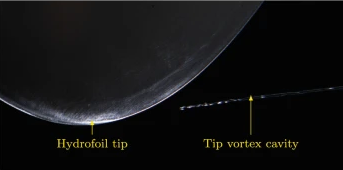 | Khoo, M T; Venning, J A; Pearce, B W; Brandner, P A Nucleation and cavitation number effects on tip vortex cavitation dynamics and noise Journal Article Experiments in Fluids, 62 (10), 2021, ISSN: 14321114. @article{Khoo2021, title = {Nucleation and cavitation number effects on tip vortex cavitation dynamics and noise}, author = {M T Khoo and J A Venning and B W Pearce and P A Brandner}, url = {https://jamesvenning.net/wp-content/uploads/2022/01/Khoo-et-al.-2021-Nucleation-and-cavitation-number-effects-on-tip-vortex-cavitation-dynamics-and-noise.pdf}, doi = {10.1007/s00348-021-03308-2}, issn = {14321114}, year = {2021}, date = {2021-12-02}, journal = {Experiments in Fluids}, volume = {62}, number = {10}, abstract = {The spatial and acoustic characteristics of tip vortex cavitation (TVC) inception were measured in a cavitation tunnel. Numerous cavitation events were recorded to reveal the influence of different nuclei populations and cavitation numbers on nuclei capture and activation physics, and the role of the streamwise pressure distribution in a vortex. Synchronised high speed video and hydrophone measurements of cavitation events were taken in the trailing vortex of an elliptical hydrofoil at an incidence of 6 ∘ and a Reynolds number of 1.5 × 10 6. The injected nuclei population in the tunnel test section was varied by using different microbubble generators mounted upstream of the test section. Both the nuclei population and cavitation number have a significant effect on the inception location distribution along the trailing vortex, and in particular, inception event rates. The cavitation number alters the flow volume subjected to tension, thereby also affecting the shape of the inception location distribution. Once the nuclei are activated, cavity kinematic and acoustic properties are influenced by the local pressure (i.e. inception location and cavitation number) more so than initial nucleus size, at least in the ∼ 50–100 $mu$ m diameter range considered in this study. Inception events that occur near the tip generate stronger acoustic pulses. At these inception locations, the frequency of the tonal peak associated with inception remains relatively constant for the two nuclei populations, but increases with cavitation number. This study provides insights into the roles of nucleation and cavitation number in TVC and informs future measurements and predictions of TVC dynamics and noise. Graphic abstract: [Figure not available: see fulltext.].}, keywords = {}, pubstate = {published}, tppubtype = {article} } The spatial and acoustic characteristics of tip vortex cavitation (TVC) inception were measured in a cavitation tunnel. Numerous cavitation events were recorded to reveal the influence of different nuclei populations and cavitation numbers on nuclei capture and activation physics, and the role of the streamwise pressure distribution in a vortex. Synchronised high speed video and hydrophone measurements of cavitation events were taken in the trailing vortex of an elliptical hydrofoil at an incidence of 6 ∘ and a Reynolds number of 1.5 × 10 6. The injected nuclei population in the tunnel test section was varied by using different microbubble generators mounted upstream of the test section. Both the nuclei population and cavitation number have a significant effect on the inception location distribution along the trailing vortex, and in particular, inception event rates. The cavitation number alters the flow volume subjected to tension, thereby also affecting the shape of the inception location distribution. Once the nuclei are activated, cavity kinematic and acoustic properties are influenced by the local pressure (i.e. inception location and cavitation number) more so than initial nucleus size, at least in the ∼ 50–100 $mu$ m diameter range considered in this study. Inception events that occur near the tip generate stronger acoustic pulses. At these inception locations, the frequency of the tonal peak associated with inception remains relatively constant for the two nuclei populations, but increases with cavitation number. This study provides insights into the roles of nucleation and cavitation number in TVC and informs future measurements and predictions of TVC dynamics and noise. Graphic abstract: [Figure not available: see fulltext.]. |
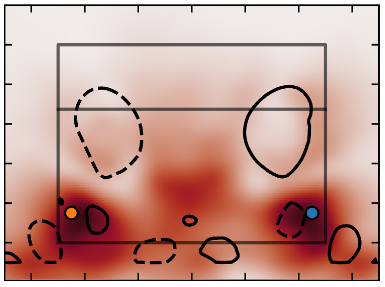 | Venning, James; McQueen, Thomas; Jacono, David Lo; Burton, David; Thompson, Mark; Sheridan, John Aspect ratio and the dynamic wake of the Ahmed body Journal Article Experimental Thermal and Fluid Science, (July), pp. 110457, 2021, ISSN: 08941777. @article{Venning2021, title = {Aspect ratio and the dynamic wake of the Ahmed body}, author = {James Venning and Thomas McQueen and David Lo Jacono and David Burton and Mark Thompson and John Sheridan}, url = {https://jamesvenning.net/wp-content/uploads/2021/08/Venning-et-al.-2021-Aspect-ratio-and-the-dynamic-wake-of-the-Ahmed-body.pdf}, doi = {10.1016/j.expthermflusci.2021.110457}, issn = {08941777}, year = {2021}, date = {2021-05-01}, journal = {Experimental Thermal and Fluid Science}, number = {July}, pages = {110457}, publisher = {Elsevier Inc.}, abstract = {The dynamic structures in the wake of the Ahmed body with a 25° slant angle were investigated. It is well established that the wake is dominated by two, counter rotating, streamwise vortex structures (C-pillar vortices). The influence these vortices have on the flow over the slant back was altered by modifying the width of the body between 60% to 120% of the standard width. The wake was measured using time-resolved particle-image velocimetry in several streamwise and spanwise planes for a height-based Reynolds number of 2.6×10^4. The wake measurements were decomposed with a spectral proper orthogonal decomposition technique, revealing two oscillatory modes. Firstly, the C-pillar vortical structures alternately contract and expand with a Strouhal number of 0.24, mildly dependent on the width. Secondly, the boundary layers on the sides of the body separate at the end of the body, forming shear layers with a dominant frequency of St = 2.30. Reducing the width of the body to 60% rotates the symmetry axis of the shedding mode. Furthermore, changing the spacing between the C-pillar vortices, by changing the width of the body, alters the nature of the spanwise vortical structures that form behind the base of the model. Intermediate width bodies produce two stable spanwise vortices. For wide bodies, the flow remains separated over the entire slant, and the top spanwise vortex does not form. Rather, the flow over the slant resembles a free shear layer with a Kelvin–Helmholtz-like instability leading to periodic shedding of small-scale vortex structures. Conversely, for narrow bodies, this phenomenon is observed at the bottom of the body and the lower spanwise vortex no longer forms while the flow over the slant remains attached.}, keywords = {}, pubstate = {published}, tppubtype = {article} } The dynamic structures in the wake of the Ahmed body with a 25° slant angle were investigated. It is well established that the wake is dominated by two, counter rotating, streamwise vortex structures (C-pillar vortices). The influence these vortices have on the flow over the slant back was altered by modifying the width of the body between 60% to 120% of the standard width. The wake was measured using time-resolved particle-image velocimetry in several streamwise and spanwise planes for a height-based Reynolds number of 2.6×10^4. The wake measurements were decomposed with a spectral proper orthogonal decomposition technique, revealing two oscillatory modes. Firstly, the C-pillar vortical structures alternately contract and expand with a Strouhal number of 0.24, mildly dependent on the width. Secondly, the boundary layers on the sides of the body separate at the end of the body, forming shear layers with a dominant frequency of St = 2.30. Reducing the width of the body to 60% rotates the symmetry axis of the shedding mode. Furthermore, changing the spacing between the C-pillar vortices, by changing the width of the body, alters the nature of the spanwise vortical structures that form behind the base of the model. Intermediate width bodies produce two stable spanwise vortices. For wide bodies, the flow remains separated over the entire slant, and the top spanwise vortex does not form. Rather, the flow over the slant resembles a free shear layer with a Kelvin–Helmholtz-like instability leading to periodic shedding of small-scale vortex structures. Conversely, for narrow bodies, this phenomenon is observed at the bottom of the body and the lower spanwise vortex no longer forms while the flow over the slant remains attached. |
 | Smith, S M; Brandner, P A; Pearce, B W; Venning, James A; Moreau, D J; Clarke, D B Steady and unsteady loads acting on a hydrofoil immersed in a turbulent boundary layer Journal Article Journal of Fluids and Structures, 102 (103225), 2021, ISSN: 0889-9746. @article{Smith2021, title = {Steady and unsteady loads acting on a hydrofoil immersed in a turbulent boundary layer}, author = {S M Smith and P A Brandner and B W Pearce and James A Venning and D J Moreau and D B Clarke}, url = {https://jamesvenning.net/wp-content/uploads/2021/08/Smith-et-al.-2021-Steady-and-unsteady-loads-acting-on-a-hydrofoil-immersed-in-a-turbulent-boundary-layer.pdf}, doi = {10.1016/j.jfluidstructs.2021.103225}, issn = {0889-9746}, year = {2021}, date = {2021-04-02}, journal = {Journal of Fluids and Structures}, volume = {102}, number = {103225}, publisher = {Elsevier Inc.}, abstract = {This study investigated steady and unsteady loads acting on a hydrofoil immersed in a turbulent boundary layer. Measurements were performed in a cavitation tunnel in which the hydrofoil was mounted spanwise normal from the test section ceiling, via a 6-component force balance. The turbulent boundary layer was artificially thickened via an array of transverse jets located upstream of the test section. The effect of boundary layer thickness was investigated, in which various thicknesses were generated to allow partial or full immersion of two hydrofoils, each with different aspect ratios. The effect of varying incidence and Reynolds number on the hydrodynamic loading was also investigated. Steady forces were found to be significantly affected by the scale of the boundary layer, particularly in the stall region. Identification of a broad peak in the unsteady force spectra, was made at a constant reduced frequency of 0.2. The peak was dependent on boundary layer thickness and Reynolds number. Furthermore, a low frequency stall component, superimposed over the existing broadband excitation of the boundary layer turbulence, was apparent in the spectra past stall.}, keywords = {}, pubstate = {published}, tppubtype = {article} } This study investigated steady and unsteady loads acting on a hydrofoil immersed in a turbulent boundary layer. Measurements were performed in a cavitation tunnel in which the hydrofoil was mounted spanwise normal from the test section ceiling, via a 6-component force balance. The turbulent boundary layer was artificially thickened via an array of transverse jets located upstream of the test section. The effect of boundary layer thickness was investigated, in which various thicknesses were generated to allow partial or full immersion of two hydrofoils, each with different aspect ratios. The effect of varying incidence and Reynolds number on the hydrodynamic loading was also investigated. Steady forces were found to be significantly affected by the scale of the boundary layer, particularly in the stall region. Identification of a broad peak in the unsteady force spectra, was made at a constant reduced frequency of 0.2. The peak was dependent on boundary layer thickness and Reynolds number. Furthermore, a low frequency stall component, superimposed over the existing broadband excitation of the boundary layer turbulence, was apparent in the spectra past stall. |
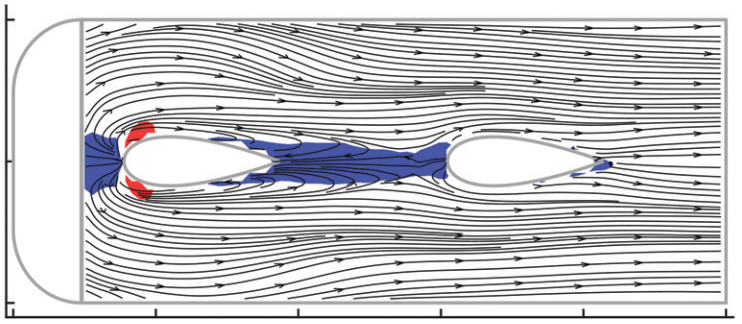 | Ekman, Petter; Venning, James; Virdung, Torbjörn; Karlsson, Matts Importance of sub-grid scale modeling for accurate aerodynamic simulations Journal Article Journal of Fluids Engineering, Transactions of the ASME, 143 (1), pp. 1–14, 2021, ISSN: 1528901X. @article{Ekman2021, title = {Importance of sub-grid scale modeling for accurate aerodynamic simulations}, author = {Petter Ekman and James Venning and Torbjörn Virdung and Matts Karlsson}, url = {https://jamesvenning.net/wp-content/uploads/2021/08/Ekman-et-al.-2021-Importance-of-sub-grid-scale-modeling-for-accurate-aerodynamic-simulations.pdf}, doi = {10.1115/1.4048351}, issn = {1528901X}, year = {2021}, date = {2021-04-01}, journal = {Journal of Fluids Engineering, Transactions of the ASME}, volume = {143}, number = {1}, pages = {1--14}, abstract = {The Ahmed body is one of the most well-investigated vehicle bodies for aerodynamic purposes. Despite its simple geometry, the flow around the body, especially at the rear, is very complex as it is dominated by a large wake with strong interaction between vortical structures. In this study, the flow around the 25 deg Ahmed body has been investigated using large eddy simulations and compared to high-resolution particle image velocimetry (PIV) measurements. Special emphasis was put on studying three commonly used sub-grid scale (SGS) models and their ability to capture vortical structures around the Ahmed body. The ability of the SGS models to capture the near-wall behavior and small-scale dissipation is crucial for capturing the correct flow field. Very good agreement between simulations and PIV measurements were seen when using the dynamic Smagorinsky-Lilly and the wall-adopting local eddy-viscosity SGS models, respectively. However, the standard Smagorinsky-Lilly model was not able to capture the flow patterns when compared to the PIV measurements due to shortcomings in the near-wall modeling in the standard Smagorinsky-Lilly model, resulting in overpredicted separation.}, keywords = {}, pubstate = {published}, tppubtype = {article} } The Ahmed body is one of the most well-investigated vehicle bodies for aerodynamic purposes. Despite its simple geometry, the flow around the body, especially at the rear, is very complex as it is dominated by a large wake with strong interaction between vortical structures. In this study, the flow around the 25 deg Ahmed body has been investigated using large eddy simulations and compared to high-resolution particle image velocimetry (PIV) measurements. Special emphasis was put on studying three commonly used sub-grid scale (SGS) models and their ability to capture vortical structures around the Ahmed body. The ability of the SGS models to capture the near-wall behavior and small-scale dissipation is crucial for capturing the correct flow field. Very good agreement between simulations and PIV measurements were seen when using the dynamic Smagorinsky-Lilly and the wall-adopting local eddy-viscosity SGS models, respectively. However, the standard Smagorinsky-Lilly model was not able to capture the flow patterns when compared to the PIV measurements due to shortcomings in the near-wall modeling in the standard Smagorinsky-Lilly model, resulting in overpredicted separation. |
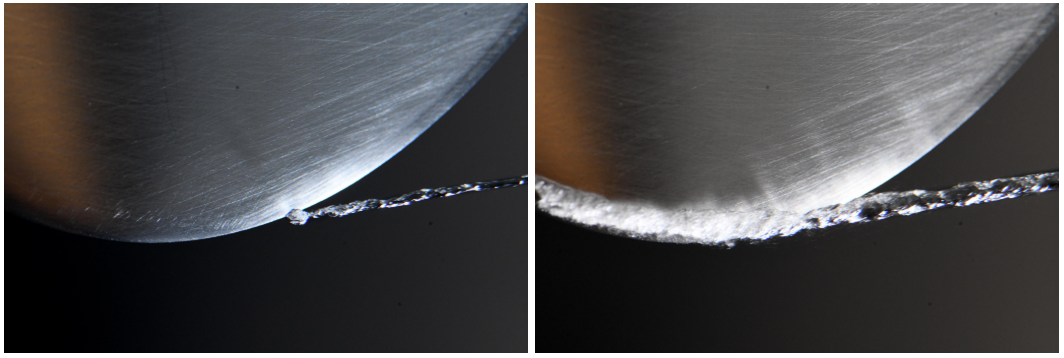 | Venning, James A; Paul, Rhys A; Khoo, Matthew T; Pearce, Bryce W; Brandner, Paul A The effect of nuclei on the attachment hysteresis in cavitating trailing vortices Inproceedings Proceedings of the 11th International Symposium on Cavitation, 2021. @inproceedings{Venning2021a, title = {The effect of nuclei on the attachment hysteresis in cavitating trailing vortices}, author = {James A Venning and Rhys A Paul and Matthew T Khoo and Bryce W Pearce and Paul A Brandner}, url = {https://jamesvenning.net/wp-content/uploads/2021/08/Venning-et-al.-2021-The-effect-of-nuclei-on-the-attachment-hysteresis-in-cavitating-trailing-vortices.pdf}, year = {2021}, date = {2021-01-01}, booktitle = {Proceedings of the 11th International Symposium on Cavitation}, abstract = {The incidence hysteresis between the attachment and detachment angles of a trailing vortex cavity behind an elliptical hydrofoil is investigated for two nuclei populations in a cavitation tunnel. Deplete and dense population were realized through natural and artificially seeded nuclei, respectively. The cavitation appearance was monitored for a range of incidences, and two hysteretic behaviours were observed. In a nuclei-deplete flow, the temporal delay required to ingest and activate a susceptible nucleus and associated additional tension caused a larger incidence for cavity attachment. With dense seeding, however, the continual supply of nuclei into the cavity sustained the attached cavity at much lower incidences.}, keywords = {}, pubstate = {published}, tppubtype = {inproceedings} } The incidence hysteresis between the attachment and detachment angles of a trailing vortex cavity behind an elliptical hydrofoil is investigated for two nuclei populations in a cavitation tunnel. Deplete and dense population were realized through natural and artificially seeded nuclei, respectively. The cavitation appearance was monitored for a range of incidences, and two hysteretic behaviours were observed. In a nuclei-deplete flow, the temporal delay required to ingest and activate a susceptible nucleus and associated additional tension caused a larger incidence for cavity attachment. With dense seeding, however, the continual supply of nuclei into the cavity sustained the attached cavity at much lower incidences. |
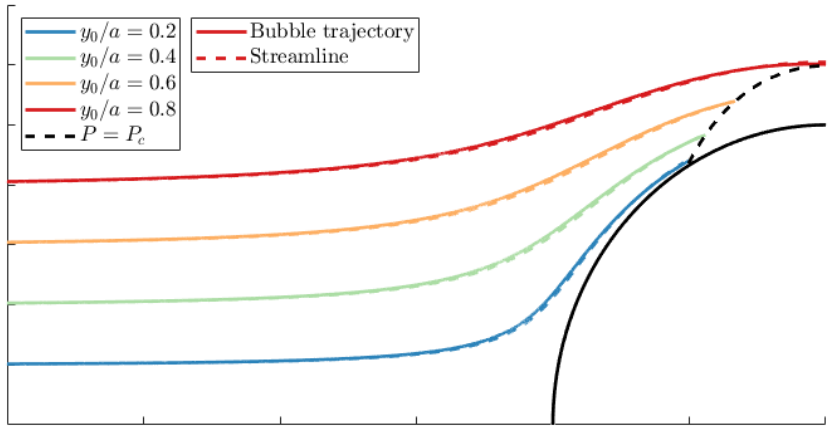 | Paul, Rhys A; Venning, James A; Brandner, Paul A Nuclei transport about a sphere Inproceedings Proceedings of the 11th International Symposium on Cavitation, 2021. @inproceedings{Paul2021, title = {Nuclei transport about a sphere}, author = {Rhys A Paul and James A Venning and Paul A Brandner}, url = {https://jamesvenning.net/wp-content/uploads/2021/08/Paul-Venning-Brandner-2021-Nuclei-transport-about-a-sphere.pdf}, year = {2021}, date = {2021-01-01}, booktitle = {Proceedings of the 11th International Symposium on Cavitation}, abstract = {Microbubble transport in a potential flow about a sphere is studied. A system of differential equations is solved numerically to model the propagation of microbubbles subject to the Kelvin impulse, pressure gradients and drag. Buoyancy due to the pressure gradient is found to be the dominant force, but the deviation from streamlines is small. Finally, the inclusion of a viscous boundary layer is shown to prevent bubbles colliding with the sphere surface.}, keywords = {}, pubstate = {published}, tppubtype = {inproceedings} } Microbubble transport in a potential flow about a sphere is studied. A system of differential equations is solved numerically to model the propagation of microbubbles subject to the Kelvin impulse, pressure gradients and drag. Buoyancy due to the pressure gradient is found to be the dominant force, but the deviation from streamlines is small. Finally, the inclusion of a viscous boundary layer is shown to prevent bubbles colliding with the sphere surface. |
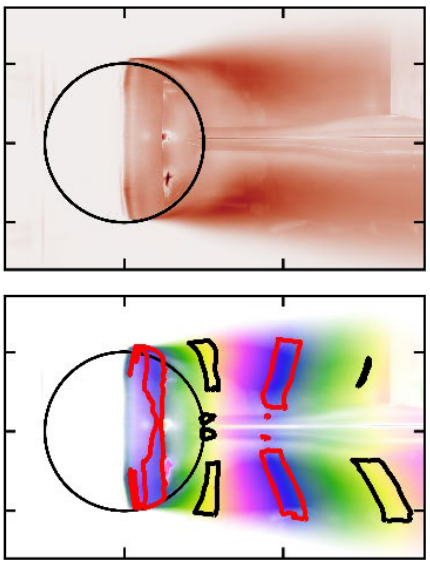 | Venning, James A; Pearce, Bryce W; Brandner, Paul A Dual-camera mode visualization of cavitating flows Inproceedings Proceedings of the 11th International Symposium on Cavitation, 2021. @inproceedings{Venning2021b, title = {Dual-camera mode visualization of cavitating flows}, author = {James A Venning and Bryce W Pearce and Paul A Brandner}, url = {https://jamesvenning.net/wp-content/uploads/2021/08/Venning-Pearce-Brandner-2021-Dual-camera-mode-visualization-of-cavitating-flows.pdf}, year = {2021}, date = {2021-01-01}, booktitle = {Proceedings of the 11th International Symposium on Cavitation}, abstract = {The global mode visualization technique presented in Venning et al. is extended to use two cameras, simultaneously recording a 3D cavitating flow from opposite directions. The cavitating flow investigated is that about a sphere at a transcritical Reynolds number of 1.5 × 106 and a cavitation number of 0.8. High-resolution data, in both time and space, allows detailed mode shapes to be obtained. The addition of the second camera significantly reduces the potential for ambiguity about the nature of the shedding modes and adds additional information in regions that would otherwise be obscured in a single- camera experiment. The global distribution of power and the phase for each cavity shedding mode are described, confirming a symmetric and asymmetric mode.}, keywords = {}, pubstate = {published}, tppubtype = {inproceedings} } The global mode visualization technique presented in Venning et al. is extended to use two cameras, simultaneously recording a 3D cavitating flow from opposite directions. The cavitating flow investigated is that about a sphere at a transcritical Reynolds number of 1.5 × 106 and a cavitation number of 0.8. High-resolution data, in both time and space, allows detailed mode shapes to be obtained. The addition of the second camera significantly reduces the potential for ambiguity about the nature of the shedding modes and adds additional information in regions that would otherwise be obscured in a single- camera experiment. The global distribution of power and the phase for each cavity shedding mode are described, confirming a symmetric and asymmetric mode. |
2020 |
|
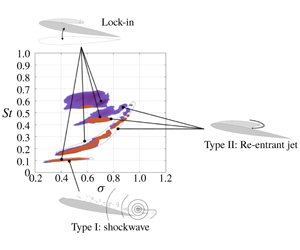 | Smith, Samuel M; Venning, James A; Pearce, Bryce W; Young, Yin Lu; Brandner, Paul A The influence of fluid-structure interaction on cloud cavitation about a flexible hydrofoil. Part 2. Journal Article Journal of Fluid Mechanics, 897 , pp. A28, 2020. @article{Smith2020b, title = {The influence of fluid-structure interaction on cloud cavitation about a flexible hydrofoil. Part 2.}, author = {Samuel M Smith and James A Venning and Bryce W Pearce and Yin Lu Young and Paul A Brandner}, url = {https://jamesvenning.net/wp-content/uploads/2020/06/Smith2020_JFM_Part2.pdf}, doi = {10.1017/jfm.2020.323}, year = {2020}, date = {2020-06-18}, journal = {Journal of Fluid Mechanics}, volume = {897}, pages = {A28}, abstract = {The influence of fluid–structure interaction on cloud cavitation about a hydrofoil is investigated by comparing results from a relatively stiff reference hydrofoil, presented in Part 1, with those obtained on a geometrically identical flexible hydrofoil. Measurements were conducted with a chord-based Reynolds number for cavitation numbers, ? , ranging from 0.2 to 1.2 while the hydrofoil was mounted at an incidence, ? , of to the oncoming flow. Tip deformations and cavitation behaviour were recorded with synchronised force measurements utilising two high-speed cameras. The flexible composite hydrofoil was manufactured as a carbon/glass-epoxy hybrid structure with a lay-up sequence selected principally to consider spanwise bending deformations with no material-induced bend–twist coupling. Hydrodynamic bend–twist coupling is seen to result in nose-up twist deformations causing frequency modulation from the increase in cavity length. The lock-in phenomenon driven by re-entrant jet shedding observed on the stiff hydrofoil is also evident on the flexible hydrofoil at ? , but occurs between different modes. Flexibility is observed to accelerate cavitation regime transition with reducing ? . This is seen with the rapid growth and influence the shockwave instability has on the forces, deflections and cavitation behaviour on the flexible hydrofoil, suggesting structural behaviour plays a significant role in modifying cavity physics. The reduced stiffness causes secondary lock-in of the flexible hydrofoil's one-quarter sub-harmonic, , at ? = 0.4. This leads to the most severe deflections observed in the conditions tested along with a shift in phase between normal force and tip deflection.}, keywords = {}, pubstate = {published}, tppubtype = {article} } The influence of fluid–structure interaction on cloud cavitation about a hydrofoil is investigated by comparing results from a relatively stiff reference hydrofoil, presented in Part 1, with those obtained on a geometrically identical flexible hydrofoil. Measurements were conducted with a chord-based Reynolds number for cavitation numbers, ? , ranging from 0.2 to 1.2 while the hydrofoil was mounted at an incidence, ? , of to the oncoming flow. Tip deformations and cavitation behaviour were recorded with synchronised force measurements utilising two high-speed cameras. The flexible composite hydrofoil was manufactured as a carbon/glass-epoxy hybrid structure with a lay-up sequence selected principally to consider spanwise bending deformations with no material-induced bend–twist coupling. Hydrodynamic bend–twist coupling is seen to result in nose-up twist deformations causing frequency modulation from the increase in cavity length. The lock-in phenomenon driven by re-entrant jet shedding observed on the stiff hydrofoil is also evident on the flexible hydrofoil at ? , but occurs between different modes. Flexibility is observed to accelerate cavitation regime transition with reducing ? . This is seen with the rapid growth and influence the shockwave instability has on the forces, deflections and cavitation behaviour on the flexible hydrofoil, suggesting structural behaviour plays a significant role in modifying cavity physics. The reduced stiffness causes secondary lock-in of the flexible hydrofoil's one-quarter sub-harmonic, , at ? = 0.4. This leads to the most severe deflections observed in the conditions tested along with a shift in phase between normal force and tip deflection. |
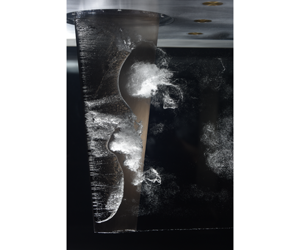 | Smith, Samuel M; Venning, James A; Pearce, Bryce W; Young, Yin Lu; Brandner, Paul A The influence of fluid-structure interaction on cloud cavitation about a stiff hydrofoil. Part 1. Journal Article Journal of Fluid Mechanics, 896 , pp. A1, 2020, ISSN: 14697645. @article{Smith2020, title = {The influence of fluid-structure interaction on cloud cavitation about a stiff hydrofoil. Part 1.}, author = {Samuel M Smith and James A Venning and Bryce W Pearce and Yin Lu Young and Paul A Brandner}, url = {https://jamesvenning.net/wp-content/uploads/2020/06/Smith2020_JFM_Part1.pdf}, doi = {10.1017/jfm.2020.321}, issn = {14697645}, year = {2020}, date = {2020-06-17}, journal = {Journal of Fluid Mechanics}, volume = {896}, pages = {A1}, abstract = {The physics associated with various cavitation regimes about a hydrofoil is investigated in a variable-pressure water tunnel using high-speed photography and synchronised force measurements. Experiments were conducted on a relatively stiff stainless steel hydrofoil at a chord-based Reynolds number, for cavitation numbers, ranging from 0.2 to 1.2, with the hydrofoil experiencing sheet, cloud and supercavitation regimes. The NACA0009 model of tapered planform was vertically mounted in a cantilevered configuration to a six-component force balance at an incidence, of to the oncoming flow. Tip deformations and cavitation behaviour were recorded with synchronised force measurements utilising two high-speed cameras mounted underneath and to the side of the test section. Break-up and shedding of an attached cavity was found to be due to either interfacial instabilities, re-entrant jet formation, shockwave propagation or a complex coupled mechanism, depending on. Three primary shedding modes are identified. The Type IIa and IIb re-entrant jet-driven oscillations exhibit a non-linear dependence on, decreasing in frequency with decreasing due to growth in the cavity length, and occur at higher values (Type IIa: 0.4-1.0; Type IIb: 0.7-0.9). Shockwave-driven Type I shedding occurs for lower values (0.3-0.6) with the oscillation frequency being practically independent of. The Type IIa oscillations locked in to the first sub-harmonic of the hydrofoil's first bending mode in water which has been modulated due to the reduced added mass of the vapour cavity. Supplementary movies are available with the online version of the paper.}, keywords = {}, pubstate = {published}, tppubtype = {article} } The physics associated with various cavitation regimes about a hydrofoil is investigated in a variable-pressure water tunnel using high-speed photography and synchronised force measurements. Experiments were conducted on a relatively stiff stainless steel hydrofoil at a chord-based Reynolds number, for cavitation numbers, ranging from 0.2 to 1.2, with the hydrofoil experiencing sheet, cloud and supercavitation regimes. The NACA0009 model of tapered planform was vertically mounted in a cantilevered configuration to a six-component force balance at an incidence, of to the oncoming flow. Tip deformations and cavitation behaviour were recorded with synchronised force measurements utilising two high-speed cameras mounted underneath and to the side of the test section. Break-up and shedding of an attached cavity was found to be due to either interfacial instabilities, re-entrant jet formation, shockwave propagation or a complex coupled mechanism, depending on. Three primary shedding modes are identified. The Type IIa and IIb re-entrant jet-driven oscillations exhibit a non-linear dependence on, decreasing in frequency with decreasing due to growth in the cavity length, and occur at higher values (Type IIa: 0.4-1.0; Type IIb: 0.7-0.9). Shockwave-driven Type I shedding occurs for lower values (0.3-0.6) with the oscillation frequency being practically independent of. The Type IIa oscillations locked in to the first sub-harmonic of the hydrofoil's first bending mode in water which has been modulated due to the reduced added mass of the vapour cavity. Supplementary movies are available with the online version of the paper. |
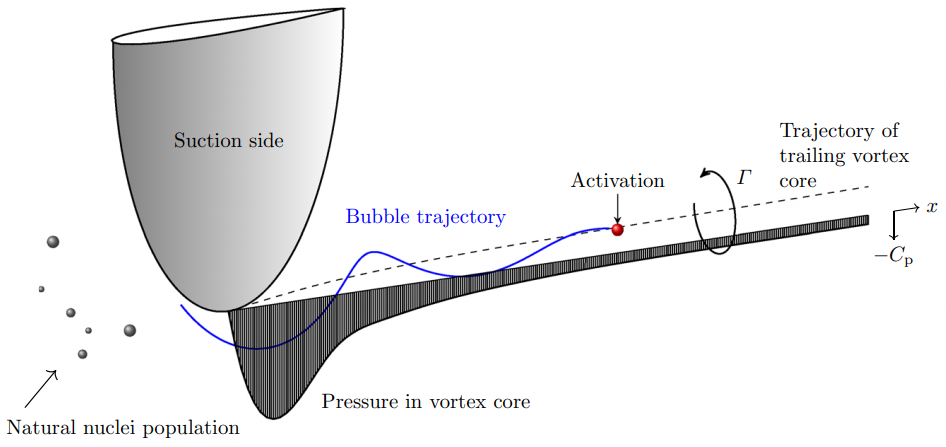 | Khoo, M T; Venning, J A; Pearce, B W; Brandner, P A Statistical aspects of tip vortex cavitation inception and desinence in a nuclei deplete flow Journal Article Experiments in Fluids, 61 , 2020, ISSN: 1432-1114. @article{Khoo2020b, title = {Statistical aspects of tip vortex cavitation inception and desinence in a nuclei deplete flow}, author = {M T Khoo and J A Venning and B W Pearce and P A Brandner}, url = {https://jamesvenning.net/wp-content/uploads/2020/06/Khoo2020_TrailingVortices.pdf}, doi = {10.1007/s00348-020-02967-x}, issn = {1432-1114}, year = {2020}, date = {2020-06-05}, journal = {Experiments in Fluids}, volume = {61}, publisher = {Springer Berlin Heidelberg}, abstract = {Tip vortex cavitation (TVC) inception and desinence behaviour of a NACA 0012 cross section, elliptical hydrofoil is investigated from a statistical perspective in a cavitation tunnel. Measurements were made for incidences from 4∘ to 16∘ and Reynolds numbers from 1.0×10^6 to 2.1×10^6. The statistics of TVC inception were quantified by taking repeated measurements of the time until the appearance of a tip vortex cavity for a range of fixed incidences. In other experiments, the angle of attack was continuously increased until inception and then decreased until desinence for a range of fixed cavitation numbers. The data were primarily acquired via an automated process using a laser and photodiode to detect the presence of a cavity. Measurements show that TVC inception in a nuclei deplete flow is a probabilistic process for which a large dataset is required for accurate characterisation. The probability of ingesting and activating a nucleus increases with time at a given test condition due to the increased volume of water exposed to low pressures. TVC desinence exhibits far less statistical variation than inception and is largely independent of the natural nuclei population. It does, however, exhibit hysteresis which is dependent on the topology of the cavitating flow. For the desinence of unattached cavitation, there is a small hysteresis between the inception and desinence indices. However, desinence is delayed for attached cavitation.}, keywords = {}, pubstate = {published}, tppubtype = {article} } Tip vortex cavitation (TVC) inception and desinence behaviour of a NACA 0012 cross section, elliptical hydrofoil is investigated from a statistical perspective in a cavitation tunnel. Measurements were made for incidences from 4∘ to 16∘ and Reynolds numbers from 1.0×10^6 to 2.1×10^6. The statistics of TVC inception were quantified by taking repeated measurements of the time until the appearance of a tip vortex cavity for a range of fixed incidences. In other experiments, the angle of attack was continuously increased until inception and then decreased until desinence for a range of fixed cavitation numbers. The data were primarily acquired via an automated process using a laser and photodiode to detect the presence of a cavity. Measurements show that TVC inception in a nuclei deplete flow is a probabilistic process for which a large dataset is required for accurate characterisation. The probability of ingesting and activating a nucleus increases with time at a given test condition due to the increased volume of water exposed to low pressures. TVC desinence exhibits far less statistical variation than inception and is largely independent of the natural nuclei population. It does, however, exhibit hysteresis which is dependent on the topology of the cavitating flow. For the desinence of unattached cavitation, there is a small hysteresis between the inception and desinence indices. However, desinence is delayed for attached cavitation. |
 | Khoo, M T; Venning, J A; Pearce, B W; Takahashi, K; Mori, T; Brandner, P A Natural nuclei population dynamics in cavitation tunnels Journal Article Experiments in Fluids, 61 , pp. 1–20, 2020, ISSN: 14321114. @article{Khoo2020, title = {Natural nuclei population dynamics in cavitation tunnels}, author = {M T Khoo and J A Venning and B W Pearce and K Takahashi and T Mori and P A Brandner}, url = {https://jamesvenning.net/wp-content/uploads/2020/03/Khoo-2020-Natural-nuclei-population-dynamics-in-cavitation-tunnels-AAM.pdf}, doi = {10.1007/s00348-019-2843-x}, issn = {14321114}, year = {2020}, date = {2020-01-01}, journal = {Experiments in Fluids}, volume = {61}, pages = {1--20}, publisher = {Springer Berlin Heidelberg}, abstract = {Nuclei, or microbubble, populations control the inception and dynamics of cavitation. It is, therefore, important to quantify distributions in cavitation test facilities to rigorously model nucleation dynamics. Measurements of natural nuclei population dynamics were made in two test facilities in Australia and Japan via mechanical activation using a Cavitation Susceptibility Meter (CSM). A range of tunnel operating parameters, including pressure, velocity and dissolved oxygen (DO) content, were investigated. The DO saturation condition upstream of the test section is found to provide a threshold as to whether the population is affected by DO in the Australian test facility. Historical trends in the population are quantified, indicating that regular monitoring is required. Variation of the population around the Australian cavitation tunnel circuit was studied by varying the water sampling location. Provided the water remains undersaturated, as defined above, the natural nuclei population in the test section can be measured by sampling from the lower limb resorber. Comparisons are made between test facilities in Australia, Japan and other countries, as well as environmental waters, using different measurement techniques. Optical and acoustic methods show microbubbles in the size range of 10–100 $mu$m typical of those used to model cavitation nucleation. CSM measurements show varying distributions of nuclei with equivalent bubble diameters in the range of 0.5–5 $mu$m but global trends suggest a universal characteristic. Graphic abstract: [Figure not available: see fulltext.].}, keywords = {}, pubstate = {published}, tppubtype = {article} } Nuclei, or microbubble, populations control the inception and dynamics of cavitation. It is, therefore, important to quantify distributions in cavitation test facilities to rigorously model nucleation dynamics. Measurements of natural nuclei population dynamics were made in two test facilities in Australia and Japan via mechanical activation using a Cavitation Susceptibility Meter (CSM). A range of tunnel operating parameters, including pressure, velocity and dissolved oxygen (DO) content, were investigated. The DO saturation condition upstream of the test section is found to provide a threshold as to whether the population is affected by DO in the Australian test facility. Historical trends in the population are quantified, indicating that regular monitoring is required. Variation of the population around the Australian cavitation tunnel circuit was studied by varying the water sampling location. Provided the water remains undersaturated, as defined above, the natural nuclei population in the test section can be measured by sampling from the lower limb resorber. Comparisons are made between test facilities in Australia, Japan and other countries, as well as environmental waters, using different measurement techniques. Optical and acoustic methods show microbubbles in the size range of 10–100 $mu$m typical of those used to model cavitation nucleation. CSM measurements show varying distributions of nuclei with equivalent bubble diameters in the range of 0.5–5 $mu$m but global trends suggest a universal characteristic. Graphic abstract: [Figure not available: see fulltext.]. |
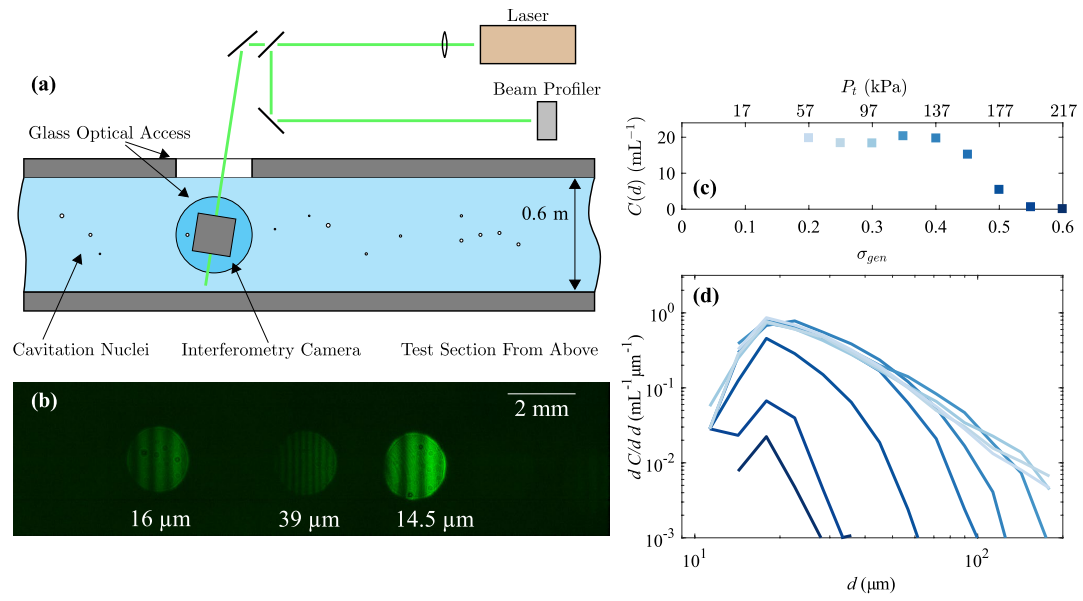 | Russell, Patrick S; Barbaca, Luka; Venning, James A; Pearce, Bryce W; Brandner, Paul A Measurement of nuclei seeding in hydrodynamic test facilities Journal Article Experiments in Fluids, 61 , pp. 1–18, 2020, ISSN: 14321114. @article{Russell2020a, title = {Measurement of nuclei seeding in hydrodynamic test facilities}, author = {Patrick S Russell and Luka Barbaca and James A Venning and Bryce W Pearce and Paul A Brandner}, url = {https://jamesvenning.net/wp-content/uploads/2020/04/Russell_Barbaca_Venning_Pearce_Brandner_EXIF2020_tunnel_measurements.pdf}, doi = {10.1007/s00348-020-2911-2}, issn = {14321114}, year = {2020}, date = {2020-01-01}, journal = {Experiments in Fluids}, volume = {61}, pages = {1--18}, publisher = {Springer Berlin Heidelberg}, abstract = {Microbubble populations within the test section of a variable-pressure water tunnel have been characterised for various operating conditions. The tunnel was operated with demineralised water and artificially seeded with microbubbles from an array of generators located in a plenum upstream of the tunnel contraction. The generators produce a polydisperse population of microbubbles 10–200 $mu$ m in the diameter. The microbubbles are generated from supersaturated feed water within a confined turbulent cavitating microjet. The generator and tunnel operating parameters were systematically varied to map the range of nuclei concentrations and size ranges possible in the test section. Microbubbles were measured with Mie Scattering Imaging (MSI), an interferometric sizing technique. A new method was introduced to calibrate the detection volume and extend the dynamic range of the MSI. The acquisition and processing of microbubble measurements with MSI have a fast turn-around such that nuclei concentration measurements are approaching real time. Estimation of the total bubble concentration was within 5% of the sampled concentration after only 100 detections but 104 were necessary for full histogram convergence. The tunnel is operated with water at low dissolved gas content to ensure all injected microbubbles dissolve and do not complete the tunnel circuit. As a result of this, the injected population is altered by dissolution as well as pressure change during the short residence between plenum and test section. The transformation is shown to be complex, changing with tunnel operating conditions. The measured test section nuclei populations were found to follow a power law for the higher concentrations. Test section nuclei concentrations of 0–24 mL - 1 can be achieved through variation of generator and tunnel operating parameters. Graphic abstract: a A schematic of the experiment. b Sample image data. c Measured concentration of the seeded microbubble cavitation nuclei. d Distribution of bubble concentration by size. [Figure not available: see fulltext.].}, keywords = {}, pubstate = {published}, tppubtype = {article} } Microbubble populations within the test section of a variable-pressure water tunnel have been characterised for various operating conditions. The tunnel was operated with demineralised water and artificially seeded with microbubbles from an array of generators located in a plenum upstream of the tunnel contraction. The generators produce a polydisperse population of microbubbles 10–200 $mu$ m in the diameter. The microbubbles are generated from supersaturated feed water within a confined turbulent cavitating microjet. The generator and tunnel operating parameters were systematically varied to map the range of nuclei concentrations and size ranges possible in the test section. Microbubbles were measured with Mie Scattering Imaging (MSI), an interferometric sizing technique. A new method was introduced to calibrate the detection volume and extend the dynamic range of the MSI. The acquisition and processing of microbubble measurements with MSI have a fast turn-around such that nuclei concentration measurements are approaching real time. Estimation of the total bubble concentration was within 5% of the sampled concentration after only 100 detections but 104 were necessary for full histogram convergence. The tunnel is operated with water at low dissolved gas content to ensure all injected microbubbles dissolve and do not complete the tunnel circuit. As a result of this, the injected population is altered by dissolution as well as pressure change during the short residence between plenum and test section. The transformation is shown to be complex, changing with tunnel operating conditions. The measured test section nuclei populations were found to follow a power law for the higher concentrations. Test section nuclei concentrations of 0–24 mL - 1 can be achieved through variation of generator and tunnel operating parameters. Graphic abstract: a A schematic of the experiment. b Sample image data. c Measured concentration of the seeded microbubble cavitation nuclei. d Distribution of bubble concentration by size. [Figure not available: see fulltext.]. |
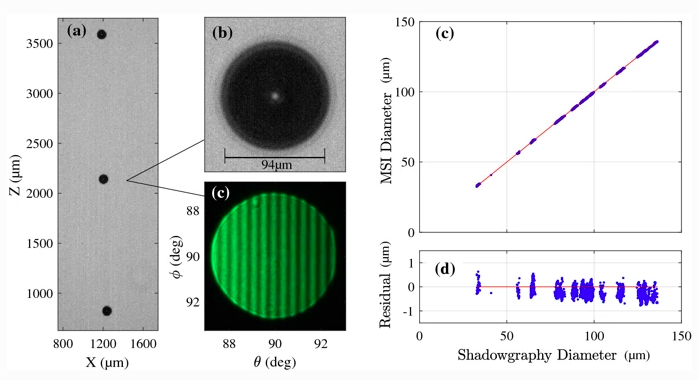 | Russell, Patrick; Venning, James; Pearce, Bryce W; Brandner, Paul A Calibration of Mie scattering imaging for microbubble measurement in hydrodynamic test facilities Journal Article Experiments in Fluids, 61 , pp. 1–17, 2020, ISSN: 14321114. @article{Russell2020b, title = {Calibration of Mie scattering imaging for microbubble measurement in hydrodynamic test facilities}, author = {Patrick Russell and James Venning and Bryce W Pearce and Paul A Brandner}, url = {https://jamesvenning.net/wp-content/uploads/2020/04/Russell_Venning_Pearce_Brandner_EXIF2020_Calibration.pdf}, doi = {10.1007/s00348-020-2927-7}, issn = {14321114}, year = {2020}, date = {2020-01-01}, journal = {Experiments in Fluids}, volume = {61}, pages = {1--17}, publisher = {Springer Berlin Heidelberg}, abstract = {Calibration of the Mie Scattering Imaging (MSI) technique for microbubble size and concentration measurement in hydrodynamic test facilities is investigated. Monodisperse bubbles are generated by a microfluidic ‘T' junction, and individual bubbles simultaneously imaged with shadowgraphy and MSI. Nominal bubble diameters between 30 and 150 $mu$m were tested. The influence of fringe uniformity and intensity for each polarisation on measurement precision was investigated. Parallel polari- sation was chosen over perpendicular for its more uniform spacing despite the lower intensity. The linear relation between fringe wavelength and bubble diameter was demonstrated at a measurement angle of 90 degrees. The calibration was derived from constants for light scattering, and for the imaging optics. The wavelength of the scattered fringe pattern is predicted using the Lorentz–Mie theory. A practical method for the calibration of interference patterns is presented. Using this approach, the measured bubble diameters from the shadowgraphy and MSI compare to within 1 $mu$m . A method for determining the size-dependent measurement volume for axisymmetric and arbitrary beam profiles is also presented.}, keywords = {}, pubstate = {published}, tppubtype = {article} } Calibration of the Mie Scattering Imaging (MSI) technique for microbubble size and concentration measurement in hydrodynamic test facilities is investigated. Monodisperse bubbles are generated by a microfluidic ‘T' junction, and individual bubbles simultaneously imaged with shadowgraphy and MSI. Nominal bubble diameters between 30 and 150 $mu$m were tested. The influence of fringe uniformity and intensity for each polarisation on measurement precision was investigated. Parallel polari- sation was chosen over perpendicular for its more uniform spacing despite the lower intensity. The linear relation between fringe wavelength and bubble diameter was demonstrated at a measurement angle of 90 degrees. The calibration was derived from constants for light scattering, and for the imaging optics. The wavelength of the scattered fringe pattern is predicted using the Lorentz–Mie theory. A practical method for the calibration of interference patterns is presented. Using this approach, the measured bubble diameters from the shadowgraphy and MSI compare to within 1 $mu$m . A method for determining the size-dependent measurement volume for axisymmetric and arbitrary beam profiles is also presented. |
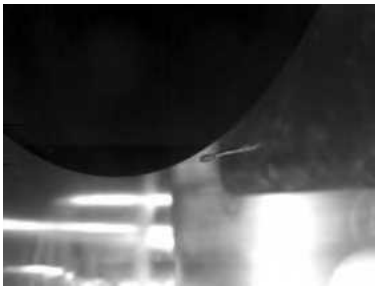 | Mori, Takayuki; Takahashi, Kenshiro; Khoo, Matthew; Venning, James Experiments on the Scaling of Tip Vortex Cavitation Inception for Elliptical Hydrofoils Inproceedings Spring Meeting of The Japan Society of Naval Architects and Ocean Engineers, pp. 355–359, 2020. BibTeX | Links: @inproceedings{Mori2020, title = {Experiments on the Scaling of Tip Vortex Cavitation Inception for Elliptical Hydrofoils}, author = {Takayuki Mori and Kenshiro Takahashi and Matthew Khoo and James Venning}, url = {https://jamesvenning.net/wp-content/uploads/2020/07/Mori-et-al.pdf}, year = {2020}, date = {2020-01-01}, booktitle = {Spring Meeting of The Japan Society of Naval Architects and Ocean Engineers}, pages = {355--359}, keywords = {}, pubstate = {published}, tppubtype = {inproceedings} } |
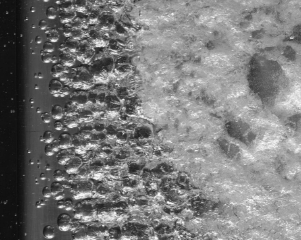 | Venning, James A; Pearce, Bryce W; Brandner, Paul A Control of Cloud Cavitation through Microbubbles Inproceedings Proceedings of the 21st Australasian Fluid Mechanics Conference, AFMC 2020, Brisbane, Australia, 2020. @inproceedings{Venning2020a, title = {Control of Cloud Cavitation through Microbubbles}, author = {James A Venning and Bryce W Pearce and Paul A Brandner}, url = {https://jamesvenning.net/wp-content/uploads/2021/01/Venning-Pearce-Brandner-2020-Control-of-Cloud-Cavitation-through-Microbubbles.pdf}, doi = {10.14264/3962085}, year = {2020}, date = {2020-01-01}, booktitle = {Proceedings of the 21st Australasian Fluid Mechanics Conference, AFMC 2020}, address = {Brisbane, Australia}, abstract = {The dynamics of cloud cavitation about a 3D hydrofoil are investigated experimentally in a cavitation tunnel with de- plete, sparse and abundant freestream nuclei populations. The rectangular-planform, NACA0015 hydrofoil was tested at a Reynolds number of 1.4×106, an incidence of 6◦ and a cav- itation number of 0.55. High-speed photography of cavita- tion shedding phenomena was acquired simultaneously with unsteady force measurement to enable identification of cav- ity shedding modes corresponding with force spectral peaks. Nuclei populations were varied through the injection of poly- disperse microbubbles. Both the deplete and abundant cases were characterised by large-scale cloud cavitation. For a sparsely seeded flow, however, coherent fluctuations are sig- nificantly reduced due to random nuclei activation and cavity breakup resulting in minimum relative unsteady lift.}, keywords = {}, pubstate = {published}, tppubtype = {inproceedings} } The dynamics of cloud cavitation about a 3D hydrofoil are investigated experimentally in a cavitation tunnel with de- plete, sparse and abundant freestream nuclei populations. The rectangular-planform, NACA0015 hydrofoil was tested at a Reynolds number of 1.4×106, an incidence of 6◦ and a cav- itation number of 0.55. High-speed photography of cavita- tion shedding phenomena was acquired simultaneously with unsteady force measurement to enable identification of cav- ity shedding modes corresponding with force spectral peaks. Nuclei populations were varied through the injection of poly- disperse microbubbles. Both the deplete and abundant cases were characterised by large-scale cloud cavitation. For a sparsely seeded flow, however, coherent fluctuations are sig- nificantly reduced due to random nuclei activation and cavity breakup resulting in minimum relative unsteady lift. |
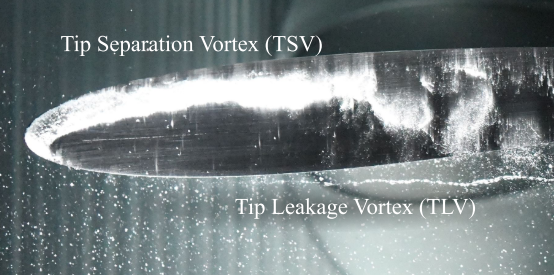 | Russell, Patrick; Barbaca, Luka; Venning, James; Pearce, Bryce; Brandner, Paul Nucleation Effects on Tip-Gap Cavitation Inproceedings Proceedings of the 21st Australasian Fluid Mechanics Conference, AFMC 2020, Brisbane, Australia, 2020. @inproceedings{Russell2020bb, title = {Nucleation Effects on Tip-Gap Cavitation}, author = {Patrick Russell and Luka Barbaca and James Venning and Bryce Pearce and Paul Brandner}, url = {https://jamesvenning.net/wp-content/uploads/2021/01/Russell-et-al.-2020-Nucleation-Effects-on-Tip-Gap-Cavitation.pdf}, doi = {10.14264/da5bd86}, year = {2020}, date = {2020-01-01}, booktitle = {Proceedings of the 21st Australasian Fluid Mechanics Conference, AFMC 2020}, address = {Brisbane, Australia}, abstract = {Cavitation in tip leakage flows have been investigated in a water tunnel for different concentrations of free-stream cavitation nu- clei. High-resolution still photography exhibits similar cavita- tion topology overall. However, hydro-acoustic measurements reveal stark differences in the desinent extinction of cavitation when different levels of active nuclei are present. Results quan- tify the anticipated challenges in designing enclosed propulsors and turbo-machinery that operate in flows with varying suscep- tibility to cavitation.}, keywords = {}, pubstate = {published}, tppubtype = {inproceedings} } Cavitation in tip leakage flows have been investigated in a water tunnel for different concentrations of free-stream cavitation nu- clei. High-resolution still photography exhibits similar cavita- tion topology overall. However, hydro-acoustic measurements reveal stark differences in the desinent extinction of cavitation when different levels of active nuclei are present. Results quan- tify the anticipated challenges in designing enclosed propulsors and turbo-machinery that operate in flows with varying suscep- tibility to cavitation. |
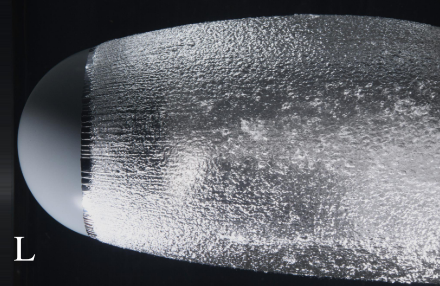 | Venning, James A; Pearce, Bryce W; Brandner, Paul A Scale Effects on Cavitation about a Sphere Inproceedings Proceedings of the 21st Australasian Fluid Mechanics Conference, AFMC 2020, Brisbane, Australia, 2020. @inproceedings{Venning2020e, title = {Scale Effects on Cavitation about a Sphere}, author = {James A Venning and Bryce W Pearce and Paul A Brandner}, url = {https://jamesvenning.net/wp-content/uploads/2021/01/Venning-Pearce-Brandner-2020-Scale-Effects-on-Cavitation-about-a-Sphere.pdf}, doi = {10.14264/843f2ec}, year = {2020}, date = {2020-01-01}, booktitle = {Proceedings of the 21st Australasian Fluid Mechanics Conference, AFMC 2020}, address = {Brisbane, Australia}, abstract = {The cavity topology about a sphere is provided for a range of Reynolds numbers from 1.25x10^5 to 1.5x10^6. This decade range was achieved through three different diameter spheres and changing the freestream velocity. Various cavitation regimes were investigated including sheet cavitation, unsteady shedding of cloud cavitation, and supercavitation. High-resolution photography was used to capture the cavity state and allowed measurement of the cavity detachment angle. Two Reynolds number transitions were observed. Comparisons of cavity appearance at the same Reynolds and cavitation numbers, but different physical scales, show the influence of the Weber number.}, keywords = {}, pubstate = {published}, tppubtype = {inproceedings} } The cavity topology about a sphere is provided for a range of Reynolds numbers from 1.25x10^5 to 1.5x10^6. This decade range was achieved through three different diameter spheres and changing the freestream velocity. Various cavitation regimes were investigated including sheet cavitation, unsteady shedding of cloud cavitation, and supercavitation. High-resolution photography was used to capture the cavity state and allowed measurement of the cavity detachment angle. Two Reynolds number transitions were observed. Comparisons of cavity appearance at the same Reynolds and cavitation numbers, but different physical scales, show the influence of the Weber number. |
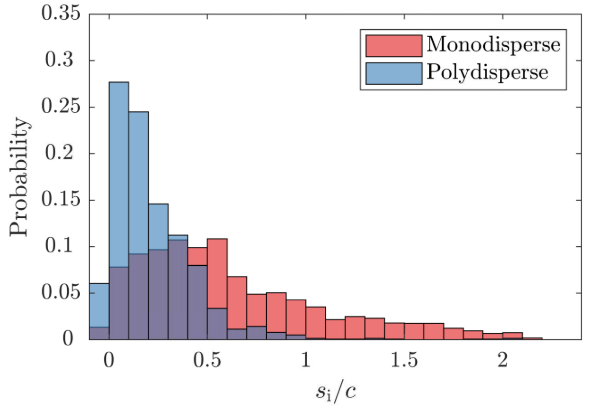 | Khoo, M T; Venning, J A; Pearce, B W; Brandner, P A Nucleation effects on hydrofoil tip vortex cavitation Inproceedings Proceedings of the 21st Australasian Fluid Mechanics Conference, AFMC 2020, pp. 7–10, Brisbane, Australia, 2020, ISBN: 9780646597843. @inproceedings{Khoo2020d, title = {Nucleation effects on hydrofoil tip vortex cavitation}, author = {M T Khoo and J A Venning and B W Pearce and P A Brandner}, url = {https://jamesvenning.net/wp-content/uploads/2021/01/Khoo-et-al.-2020-Nucleation-effects-on-hydrofoil-tip-vortex-cavitation.pdf}, doi = {10.14264/015283f}, isbn = {9780646597843}, year = {2020}, date = {2020-01-01}, booktitle = {Proceedings of the 21st Australasian Fluid Mechanics Conference, AFMC 2020}, number = {December}, pages = {7--10}, address = {Brisbane, Australia}, abstract = {Nuclei, or microbubble, populations are inextricably linked to tip vortex cavitation (TVC) inception and dynamics. In order to gain a better quantitative understanding of this relationship, high-speed video measurements were taken in a cavitation tun- nel of TVC inception locations about an elliptical hydrofoil in flows with mono- and polydisperse injected nuclei populations. Sample sizes of O(1000) were acquired. For both populations, inception occurred between 0.02 chord lengths upstream of the hydrofoil tip and about 2.1 chord lengths downstream along the cavity trajectory. However, inception location distribution var- ied significantly with nuclei population. This is explained by the higher concentrations of weaker nuclei in the monodisperse case, which increases the distance along the vortex within which nuclei are susceptible to cavitation. These results provide the foundation for studies on TVC dynamics and acoustics.}, keywords = {}, pubstate = {published}, tppubtype = {inproceedings} } Nuclei, or microbubble, populations are inextricably linked to tip vortex cavitation (TVC) inception and dynamics. In order to gain a better quantitative understanding of this relationship, high-speed video measurements were taken in a cavitation tun- nel of TVC inception locations about an elliptical hydrofoil in flows with mono- and polydisperse injected nuclei populations. Sample sizes of O(1000) were acquired. For both populations, inception occurred between 0.02 chord lengths upstream of the hydrofoil tip and about 2.1 chord lengths downstream along the cavity trajectory. However, inception location distribution var- ied significantly with nuclei population. This is explained by the higher concentrations of weaker nuclei in the monodisperse case, which increases the distance along the vortex within which nuclei are susceptible to cavitation. These results provide the foundation for studies on TVC dynamics and acoustics. |
2019 |
|
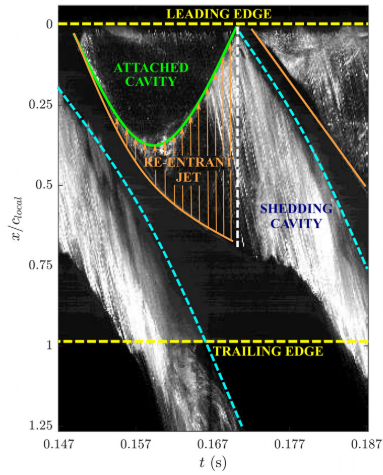 | Smith, Samuel M; Venning, James A; Giosio, Dean R; Brandner, Paul A; Pearce, Bryce W; Young, Yin L Cloud Cavitation Behavior on a Hydrofoil Due to Fluid-Structure Interaction Journal Article Journal of Fluids Engineering, 141 (4), pp. 1–8, 2019, ISSN: 1528901X. @article{Smith2019, title = {Cloud Cavitation Behavior on a Hydrofoil Due to Fluid-Structure Interaction}, author = {Samuel M Smith and James A Venning and Dean R Giosio and Paul A Brandner and Bryce W Pearce and Yin L Young}, url = {https://jamesvenning.net/wp-content/uploads/2020/04/jfe-2019-Smith-et-al.pdf}, doi = {10.1115/1.4042067}, issn = {1528901X}, year = {2019}, date = {2019-12-01}, journal = {Journal of Fluids Engineering}, volume = {141}, number = {4}, pages = {1--8}, abstract = {Despite recent extensive research into fluid-structure interaction (FSI) of cavitating hydrofoils, there remain insufficient experimental data to explain many of the observed phenomena. The cloud cavitation behavior around a hydrofoil due to the effect of FSI is investigated, utilizing rigid and compliant three-dimensional (3D) hydrofoils held in a cantilevered configuration in a cavitation tunnel. The hydrofoils have identical undeformed geometry of tapered planform with a constant modified NACA0009 profile. The rigid model is made of stainless steel and the compliant model of a carbon and glass fiber-reinforced epoxy resin with the structural fibers aligned along the spanwise direction to avoid material bend-twist coupling. Tests were conducted at an incidence of 6 deg, a mean chord-based Reynolds number of 0.7 × 106 and cavitation number of 0.8. Force measurements were simultaneously acquired with high-speed imaging to enable correlation of forces with tip bending deformations and cavity physics. Hydrofoil compliance was seen to dampen the higher frequency force fluctuations while showing strong correlation between normal force and tip deflection. The 3D nature of the flow field was seen to cause complex cavitation behavior with two shedding modes observed on both models.}, keywords = {}, pubstate = {published}, tppubtype = {article} } Despite recent extensive research into fluid-structure interaction (FSI) of cavitating hydrofoils, there remain insufficient experimental data to explain many of the observed phenomena. The cloud cavitation behavior around a hydrofoil due to the effect of FSI is investigated, utilizing rigid and compliant three-dimensional (3D) hydrofoils held in a cantilevered configuration in a cavitation tunnel. The hydrofoils have identical undeformed geometry of tapered planform with a constant modified NACA0009 profile. The rigid model is made of stainless steel and the compliant model of a carbon and glass fiber-reinforced epoxy resin with the structural fibers aligned along the spanwise direction to avoid material bend-twist coupling. Tests were conducted at an incidence of 6 deg, a mean chord-based Reynolds number of 0.7 × 106 and cavitation number of 0.8. Force measurements were simultaneously acquired with high-speed imaging to enable correlation of forces with tip bending deformations and cavity physics. Hydrofoil compliance was seen to dampen the higher frequency force fluctuations while showing strong correlation between normal force and tip deflection. The 3D nature of the flow field was seen to cause complex cavitation behavior with two shedding modes observed on both models. |
 | Venning, J A; Khoo, M T; Pearce, B W; Brandner, P A Observations on a cavitating trailing vortex behind a control surface Inproceedings MAST (Maritime/Air Systems and Technology) Asia 2019, 2019. @inproceedings{Venning2019, title = {Observations on a cavitating trailing vortex behind a control surface}, author = {J A Venning and M T Khoo and B W Pearce and P A Brandner}, url = {https://jamesvenning.net/wp-content/uploads/2021/01/Venning-et-al.-2019-Observations-on-a-cavitating-trailing-vortex-behind-a-control-surface.pdf}, year = {2019}, date = {2019-11-01}, booktitle = {MAST (Maritime/Air Systems and Technology) Asia 2019}, abstract = {Cavitation is the vapourisation of water which may occur about control or propulsive surfaces on marine platforms. Acoustic and photographic measurements have been made of the flow about a hydrofoil under various cavitation conditions. The development of the cavity is described, and quantitative measurements of the diameter variation with incidence are given. The twist in the cavity profile is shown to be stable in time. Acoustic measurements reveal the peak cavitating frequency to be a function of the hydrofoil incidence. Inception of the trailing vortex causes a 3 dB increase in the acoustic level, and leading-edge cavitation causes a further 5 dB increase. These measurements aid in understanding the physics of vortex cavitation.}, keywords = {}, pubstate = {published}, tppubtype = {inproceedings} } Cavitation is the vapourisation of water which may occur about control or propulsive surfaces on marine platforms. Acoustic and photographic measurements have been made of the flow about a hydrofoil under various cavitation conditions. The development of the cavity is described, and quantitative measurements of the diameter variation with incidence are given. The twist in the cavity profile is shown to be stable in time. Acoustic measurements reveal the peak cavitating frequency to be a function of the hydrofoil incidence. Inception of the trailing vortex causes a 3 dB increase in the acoustic level, and leading-edge cavitation causes a further 5 dB increase. These measurements aid in understanding the physics of vortex cavitation. |
Khoo, M T; Venning, J A; Peace, B W; Brandner, P A Propeller Tip Vortex Cavitation Measurements at the Australian Maritime College Cavitation Tunnel Technical Report 2019. @techreport{Khoo2019b, title = {Propeller Tip Vortex Cavitation Measurements at the Australian Maritime College Cavitation Tunnel}, author = {M T Khoo and J A Venning and B W Peace and P A Brandner}, year = {2019}, date = {2019-01-01}, keywords = {}, pubstate = {published}, tppubtype = {techreport} } | |
Khoo, M T; Venning, J A; Peace, B W; Brandner, P A Hydrofoil Tip Vortex Cavitation Measurements at the Australian Maritime College Cavitation Tunnel Technical Report Defence Science and Technology Group 2019. @techreport{Khoo2019a, title = {Hydrofoil Tip Vortex Cavitation Measurements at the Australian Maritime College Cavitation Tunnel}, author = {M T Khoo and J A Venning and B W Peace and P A Brandner}, year = {2019}, date = {2019-01-01}, institution = {Defence Science and Technology Group}, keywords = {}, pubstate = {published}, tppubtype = {techreport} } | |
Khoo, M T; Venning, J A; Takahashi, K; Arai, J; Mori, T; Pearce, B W; Brandner, P A Nuclei Distribution Measurements in Australian and Japanese Cavitation Tunnels using the Australian Maritime College Cavitation Susceptibility Meter Technical Report Defence Science and Technology Group 2019. @techreport{Khoo2019c, title = {Nuclei Distribution Measurements in Australian and Japanese Cavitation Tunnels using the Australian Maritime College Cavitation Susceptibility Meter}, author = {M T Khoo and J A Venning and K Takahashi and J Arai and T Mori and B W Pearce and P A Brandner}, year = {2019}, date = {2019-01-01}, institution = {Defence Science and Technology Group}, keywords = {}, pubstate = {published}, tppubtype = {techreport} } | |
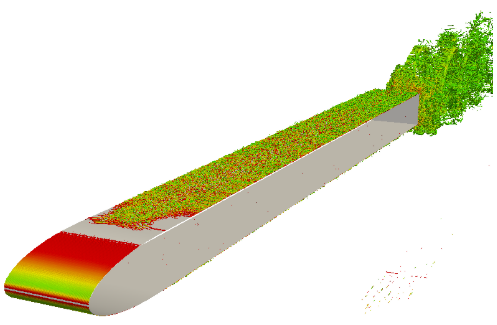 | Croaker, P; Venning, J; Karimi, M; Brandner, P; Doolan, C; Kessissoglou, N Flow-induced noise produced by a blunt edged flat plate in a reverberant water tunnel Inproceedings Proceedings of the 23rd International Congress on Acoustics, 2019. @inproceedings{Croaker2019, title = {Flow-induced noise produced by a blunt edged flat plate in a reverberant water tunnel}, author = {P Croaker and J Venning and M Karimi and P Brandner and C Doolan and N Kessissoglou}, url = {https://jamesvenning.net/wp-content/uploads/2020/04/Croaker_et-al_ICA_2019.pdf}, doi = {10.18154/RWTH-CONV-239559}, year = {2019}, date = {2019-01-01}, booktitle = {Proceedings of the 23rd International Congress on Acoustics}, abstract = {An experimental and numerical investigation of the flow around and noise produced by a blunt edged flat plate in a reverberant water tunnel is presented. The flow is at a Reynolds number based on chord of 6.8×10^6 and a Mach number of 5.3×10^−3. Experimental measurements were taken in the Australian Maritime College Cavitation Research Laboratory closed recirculating variable-pressure water tunnel. Hydrophones mounted in the tunnel wall and pressure sensors attached to the plate were used to measure the pressures generated by the turbulent flow over the plate. A large eddy simulation was also conducted, with hydrodynamic pressures on the surface of the plate extracted and combined with Curle's acoustic analogy to predict the pressure fluctuations on the wall of the water tunnel. The numerical predictions are found to agree well with the experimental measurements.}, keywords = {}, pubstate = {published}, tppubtype = {inproceedings} } An experimental and numerical investigation of the flow around and noise produced by a blunt edged flat plate in a reverberant water tunnel is presented. The flow is at a Reynolds number based on chord of 6.8×10^6 and a Mach number of 5.3×10^−3. Experimental measurements were taken in the Australian Maritime College Cavitation Research Laboratory closed recirculating variable-pressure water tunnel. Hydrophones mounted in the tunnel wall and pressure sensors attached to the plate were used to measure the pressures generated by the turbulent flow over the plate. A large eddy simulation was also conducted, with hydrodynamic pressures on the surface of the plate extracted and combined with Curle's acoustic analogy to predict the pressure fluctuations on the wall of the water tunnel. The numerical predictions are found to agree well with the experimental measurements. |
2018 |
|
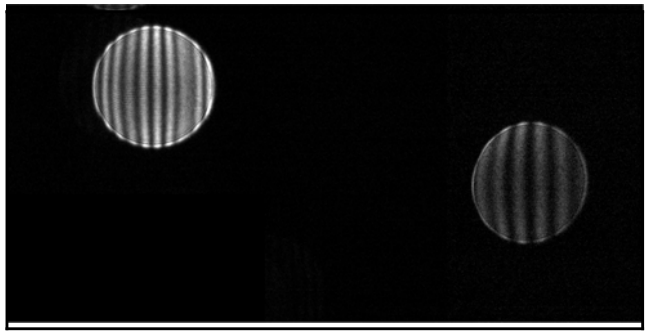 | Brandner, Paul A; Venning, James A; Pearce, Bryce W Wavelet analysis techniques in cavitating flows Journal Article Philosophical Transactions of the Royal Society A, 376 (2126), 2018. @article{Brandner2018, title = {Wavelet analysis techniques in cavitating flows}, author = {Paul A Brandner and James A Venning and Bryce W Pearce}, url = {https://jamesvenning.net/wp-content/uploads/2020/04/PRS_Wavelets-AAM.pdf}, doi = {https://doi.org/10.1098/rsta.2017.0242}, year = {2018}, date = {2018-01-01}, journal = {Philosophical Transactions of the Royal Society A}, volume = {376}, number = {2126}, abstract = {Cavitating and bubbly flows involve a host of physical phenomena and processes ranging from nucleation, surface and interfacial effects, mass transfer via diffusion and phase change to macroscopic flow physics involving bubble dynamics, turbulent flow interactions and two-phase compressible effects. The complex physics that result from these phenomena and their interactions make for flows that are difficult to investigate and analyse. From an experimental perspective, evolving sensing technology and data processing provide opportunities for gaining new insight and understanding of these complex flows, and the continuous wavelet transform (CWT) is a powerful tool to aid in their elucidation. Five case studies are presented involving many of these phenomena in which the CWT was key to data analysis and interpretation. A diverse set of experiments are presented involving a range of physical and temporal scales and experimental techniques. Bubble turbulent break-up is investigated using hydroacoustics, bubble dynamics and high-speed imaging; microbubbles are sized using light scattering and ultrasonic sensing, and large-scale coherent shedding driven by various mechanisms are analysed using simultaneous high-speed imaging and physical measurement techniques. The experimental set-up, aspect of cavitation being addressed, how the wavelets were applied, their advantages over other techniques and key findings are presented for each case study.}, keywords = {}, pubstate = {published}, tppubtype = {article} } Cavitating and bubbly flows involve a host of physical phenomena and processes ranging from nucleation, surface and interfacial effects, mass transfer via diffusion and phase change to macroscopic flow physics involving bubble dynamics, turbulent flow interactions and two-phase compressible effects. The complex physics that result from these phenomena and their interactions make for flows that are difficult to investigate and analyse. From an experimental perspective, evolving sensing technology and data processing provide opportunities for gaining new insight and understanding of these complex flows, and the continuous wavelet transform (CWT) is a powerful tool to aid in their elucidation. Five case studies are presented involving many of these phenomena in which the CWT was key to data analysis and interpretation. A diverse set of experiments are presented involving a range of physical and temporal scales and experimental techniques. Bubble turbulent break-up is investigated using hydroacoustics, bubble dynamics and high-speed imaging; microbubbles are sized using light scattering and ultrasonic sensing, and large-scale coherent shedding driven by various mechanisms are analysed using simultaneous high-speed imaging and physical measurement techniques. The experimental set-up, aspect of cavitation being addressed, how the wavelets were applied, their advantages over other techniques and key findings are presented for each case study. |
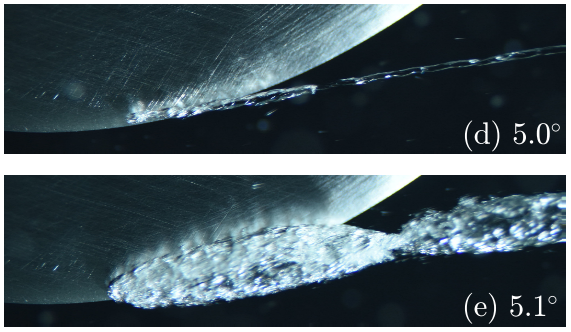 | Khoo, M T; Venning, J A; Pearce, B W; Brandner, P A Nucleation effects on hydrofoil tip vortex cavitation Inproceedings Proceedings of the 21st Australasian Fluid Mechanics Conference, AFMC 2018, pp. 1–4, 2018, ISBN: 9780646597843. @inproceedings{Khoo2018, title = {Nucleation effects on hydrofoil tip vortex cavitation}, author = {M T Khoo and J A Venning and B W Pearce and P A Brandner}, url = {https://jamesvenning.net/wp-content/uploads/2019/05/MKhoo_21AFMC_Nucleation_Effects_on_Hydrofoil_Tip_Vortex_Cavitation2.pdf}, isbn = {9780646597843}, year = {2018}, date = {2018-01-01}, booktitle = {Proceedings of the 21st Australasian Fluid Mechanics Conference, AFMC 2018}, volume = {5}, number = {December}, pages = {1--4}, abstract = {Tip vortex cavitation inception about an elliptical planform, NACA 0012 hydrofoil is investigated in cavitation tunnel flows in which cavitation nuclei are deplete and abundant. Tests were conducted at fixed Reynolds and cavitation numbers. The onset, or inception, of cavitation was induced by increasing the angle of incidence and behaviour was recorded photographically and acoustically. Cavitation inception occurred at a higher incidence in the deplete case compared with the abundant due to fewer weaker nuclei. It also occurred within a small incidence change for the deplete case, with the appearance of a continuous, cavitating vortical flow structure. Whereas for the abundant case, inception was intermittent, occurring across a larger incidence range. This was associated with individual nuclei activation events increasing in frequency with increasing incidence. Sound pressure levels increased with inception and cavity development but reduced to a local minimum once the cavity attached to the hydrofoil, increasing thereafter with incidence. Overall sound levels were higher for the abundant case than for the deplete case.}, keywords = {}, pubstate = {published}, tppubtype = {inproceedings} } Tip vortex cavitation inception about an elliptical planform, NACA 0012 hydrofoil is investigated in cavitation tunnel flows in which cavitation nuclei are deplete and abundant. Tests were conducted at fixed Reynolds and cavitation numbers. The onset, or inception, of cavitation was induced by increasing the angle of incidence and behaviour was recorded photographically and acoustically. Cavitation inception occurred at a higher incidence in the deplete case compared with the abundant due to fewer weaker nuclei. It also occurred within a small incidence change for the deplete case, with the appearance of a continuous, cavitating vortical flow structure. Whereas for the abundant case, inception was intermittent, occurring across a larger incidence range. This was associated with individual nuclei activation events increasing in frequency with increasing incidence. Sound pressure levels increased with inception and cavity development but reduced to a local minimum once the cavity attached to the hydrofoil, increasing thereafter with incidence. Overall sound levels were higher for the abundant case than for the deplete case. |
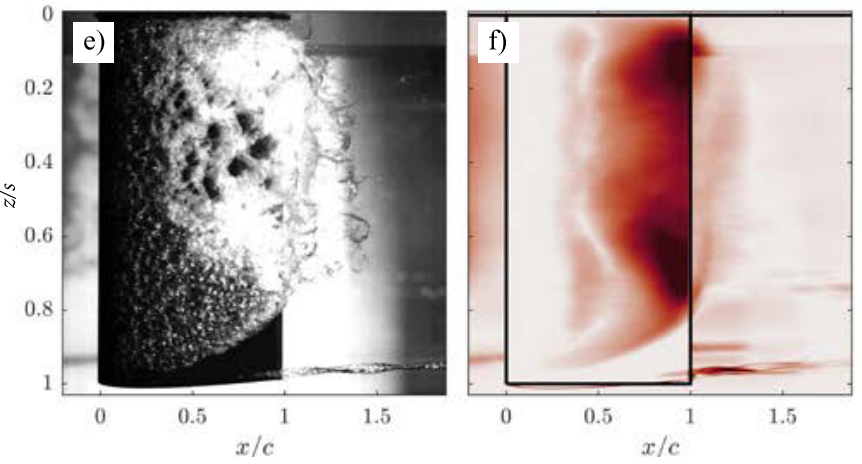 | Venning, James; Giosio, Dean; Smith, Samuel; Pearce, Bryce; Brandner, Paul The influence of nucleation on the spectral content of cloud cavitation about a hydrofoil Inproceedings Proceedings of the 10th International Symposium on Cavitation (CAV2018), pp. 1025–1030, Baltimore, 2018. @inproceedings{Venning2018d, title = {The influence of nucleation on the spectral content of cloud cavitation about a hydrofoil}, author = {James Venning and Dean Giosio and Samuel Smith and Bryce Pearce and Paul Brandner}, url = {https://jamesvenning.net/wp-content/uploads/2018/06/Venning-et-al.-2018-The-influence-of-nucleation-on-the-spectral-content-of-cloud-cavitation-about-a-hydrofoil.pdf}, doi = {10.1115/1.861851_ch195}, year = {2018}, date = {2018-01-01}, booktitle = {Proceedings of the 10th International Symposium on Cavitation (CAV2018)}, pages = {1025--1030}, address = {Baltimore}, abstract = {The influence of nucleation on the spectral content of cloud cavitation is investigated using unsteady force measurements and simultaneous high-speed imaging of a rectangular planform NACA-0015 section hydrofoil, with and without upstream nuclei injection. Experiments were conducted for cavitation numbers over the range of 0.60 to 0.45, at a chord-based test Reynolds number of 1.4 × 10^6, and at an incidence of 6°. The introduction of freestream nuclei was found to significantly alter the cavity topology and spectral content of the force response. Three shedding modes were observed in the case without nuclei injection, while two modes were present with the injection of abundant freestream nuclei. In the nuclei deplete case the dominant shedding frequency is associated with upstream shock propagation and was found to decrease with test cavitation number from a Strouhal number of 0.311 to 0.243, while the sub-harmonic and first harmonic were associated with localized tip and root activity. With the introduction of nuclei the dominant of two distinct shedding frequencies was found to be the lower frequency mode at approximately half that of the corresponding nuclei deplete case, with Strouhal number decreasing from 0.159 to 0.148. The higher frequency mode was shown to be due the propagation of an initial shockwave that only partially condenses the cavity prior to the passage of a second shockwave that leads to full span-wise condensation.}, keywords = {}, pubstate = {published}, tppubtype = {inproceedings} } The influence of nucleation on the spectral content of cloud cavitation is investigated using unsteady force measurements and simultaneous high-speed imaging of a rectangular planform NACA-0015 section hydrofoil, with and without upstream nuclei injection. Experiments were conducted for cavitation numbers over the range of 0.60 to 0.45, at a chord-based test Reynolds number of 1.4 × 10^6, and at an incidence of 6°. The introduction of freestream nuclei was found to significantly alter the cavity topology and spectral content of the force response. Three shedding modes were observed in the case without nuclei injection, while two modes were present with the injection of abundant freestream nuclei. In the nuclei deplete case the dominant shedding frequency is associated with upstream shock propagation and was found to decrease with test cavitation number from a Strouhal number of 0.311 to 0.243, while the sub-harmonic and first harmonic were associated with localized tip and root activity. With the introduction of nuclei the dominant of two distinct shedding frequencies was found to be the lower frequency mode at approximately half that of the corresponding nuclei deplete case, with Strouhal number decreasing from 0.159 to 0.148. The higher frequency mode was shown to be due the propagation of an initial shockwave that only partially condenses the cavity prior to the passage of a second shockwave that leads to full span-wise condensation. |
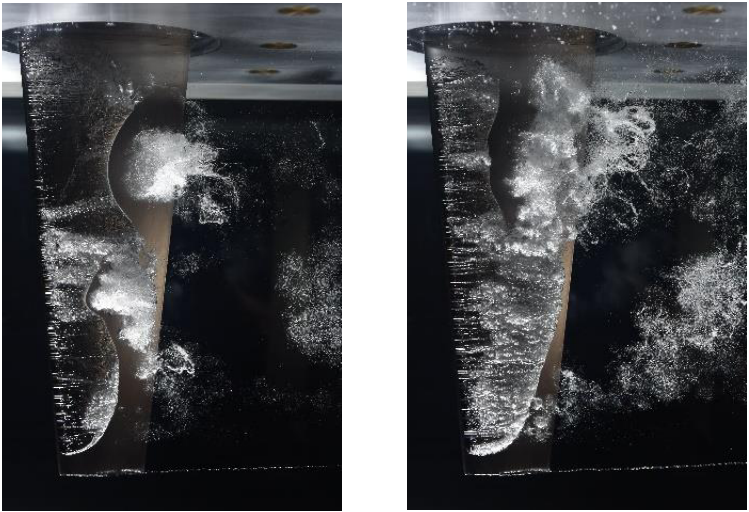 | Smith, Samuel M; Venning, James A; Brandner, Paul A; Pearce, Bryce W; Giosio, Dean R; Young, Yin Lu The Influence of Fluid-Structure Interaction on Cloud Cavitation About a Hydrofoil Inproceedings Proceedings of the 10th International Symposium on Cavitation (CAV2018), pp. 1013–1018, 2018. @inproceedings{Smith2018, title = {The Influence of Fluid-Structure Interaction on Cloud Cavitation About a Hydrofoil}, author = {Samuel M Smith and James A Venning and Paul A Brandner and Bryce W Pearce and Dean R Giosio and Yin Lu Young}, url = {https://jamesvenning.net/wp-content/uploads/2018/06/Smith-et-al.-2018-The-influence-of-fluid-structure-interaction-on-cloud-cavitation-about-a-hydrofoil.pdf}, doi = {10.1115/1.861851_ch193}, year = {2018}, date = {2018-01-01}, booktitle = {Proceedings of the 10th International Symposium on Cavitation (CAV2018)}, pages = {1013--1018}, abstract = {The dynamics of cloud cavitation about rigid and flexible 3D hydrofoils is investigated in a cavitation tunnel. The two hydrofoils have identical undeformed geometry of tapered planform, NACA-0009 section and cantilevered setup at the hydrofoil root. The rigid model is made of stainless steel and the flexible model of carbon and glass-fibre reinforced epoxy resin with an effectively quasi-isotropic lay-up without material bend-twist coupling. Tests were conducted at a fixed incidence of 6°, a chord-based Reynolds number of 0.7×10^6 and a cavitation number ranging from 1.0 to 0.2. Unsteady force measurements were made simultaneously with high-speed imaging to enable correlation of forces and with cavity dynamics. High-resolution force spectra at discrete cavitation numbers and separate pressure sweeps were taken to acquire spectrograms of frequency response as a function of cavitation number. Three shedding modes, designated as types 1, 2 and 3, are apparent for both rigid and flexible hydrofoils although significant differences in peak amplitudes were observed. Types 2 and 3 shedding occur at high cavitation numbers where frequency varied with cavitation number and high-speed imaging showed the dominant shedding mechanism to be due to re-entrant jet formation. The type 1 shedding that developed with reduction in cavitation number, once cavity lengths grew to about full-chord, occurred at a nominally constant frequency. In this case, the imaging showed the dominant mechanism to be shockwave formation. This behaviour has been reported upon extensively in literature although there are some new features apparent from the data. The flexibility of the composite hydrofoil was found to increase the magnitude of the force fluctuations for the low frequency type 1 mode compared to the rigid hydrofoil. However, hydrofoil flexibility was seen to dampen the fluctuating magnitude of the high-frequency type 2 and 3 modes, despite being close to the hydrofoil's natural frequency.}, keywords = {}, pubstate = {published}, tppubtype = {inproceedings} } The dynamics of cloud cavitation about rigid and flexible 3D hydrofoils is investigated in a cavitation tunnel. The two hydrofoils have identical undeformed geometry of tapered planform, NACA-0009 section and cantilevered setup at the hydrofoil root. The rigid model is made of stainless steel and the flexible model of carbon and glass-fibre reinforced epoxy resin with an effectively quasi-isotropic lay-up without material bend-twist coupling. Tests were conducted at a fixed incidence of 6°, a chord-based Reynolds number of 0.7×10^6 and a cavitation number ranging from 1.0 to 0.2. Unsteady force measurements were made simultaneously with high-speed imaging to enable correlation of forces and with cavity dynamics. High-resolution force spectra at discrete cavitation numbers and separate pressure sweeps were taken to acquire spectrograms of frequency response as a function of cavitation number. Three shedding modes, designated as types 1, 2 and 3, are apparent for both rigid and flexible hydrofoils although significant differences in peak amplitudes were observed. Types 2 and 3 shedding occur at high cavitation numbers where frequency varied with cavitation number and high-speed imaging showed the dominant shedding mechanism to be due to re-entrant jet formation. The type 1 shedding that developed with reduction in cavitation number, once cavity lengths grew to about full-chord, occurred at a nominally constant frequency. In this case, the imaging showed the dominant mechanism to be shockwave formation. This behaviour has been reported upon extensively in literature although there are some new features apparent from the data. The flexibility of the composite hydrofoil was found to increase the magnitude of the force fluctuations for the low frequency type 1 mode compared to the rigid hydrofoil. However, hydrofoil flexibility was seen to dampen the fluctuating magnitude of the high-frequency type 2 and 3 modes, despite being close to the hydrofoil's natural frequency. |
 | Russell, Patrick S; Giosio, Dean R; Venning, James A; Pearce, Bryce W; Brandner, Paul A; Aumelas, V; Maj, G; Russell, S; Giosio, Dean R; Venning, James A; Pearce, Bryce W; Brandner, Paul A Towards Real-Time Optical Measurement of Microbubble Content in Hydrodynamic Test Facilities Inproceedings Proceedings of the 10th International Symposium on Cavitation (CAV2018), 2018. @inproceedings{Russell2018, title = {Towards Real-Time Optical Measurement of Microbubble Content in Hydrodynamic Test Facilities}, author = {Patrick S Russell and Dean R Giosio and James A Venning and Bryce W Pearce and Paul A Brandner and V Aumelas and G Maj and S Russell and Dean R Giosio and James A Venning and Bryce W Pearce and Paul A Brandner}, url = {https://jamesvenning.net/wp-content/uploads/2018/06/Russell-et-al.-2018-Towards-real-time-optical-measurement-of-microbubble-content-in-hydrodynamic-test-facilities.pdf}, doi = {10.1115/1.861851_ch201}, year = {2018}, date = {2018-01-01}, booktitle = {Proceedings of the 10th International Symposium on Cavitation (CAV2018)}, abstract = {Real-time measurement of microbubble concentrations is desirable in order to inform experimental results, particularly in studies of cavitation physics. To develop these capabilities a controlled experiment using a micro-fluidic T-junction to produce mono-disperse microbubbles was devised with the size and frequency of microbubbles measured using a line-scan camera capable of acquiring 45k images per second. Measurements were able to be obtained and reported in under 3 seconds from the triggering time. Tests were carried out in quiescent water and implementation in non-stationary environments would extend the operational range. The principal operating mode produced microbubbles on the order of 80 to 130 µm in size at frequencies ranging from 750 to 3200 bubbles per second across the range of air and water pressures tested.}, keywords = {}, pubstate = {published}, tppubtype = {inproceedings} } Real-time measurement of microbubble concentrations is desirable in order to inform experimental results, particularly in studies of cavitation physics. To develop these capabilities a controlled experiment using a micro-fluidic T-junction to produce mono-disperse microbubbles was devised with the size and frequency of microbubbles measured using a line-scan camera capable of acquiring 45k images per second. Measurements were able to be obtained and reported in under 3 seconds from the triggering time. Tests were carried out in quiescent water and implementation in non-stationary environments would extend the operational range. The principal operating mode produced microbubbles on the order of 80 to 130 µm in size at frequencies ranging from 750 to 3200 bubbles per second across the range of air and water pressures tested. |
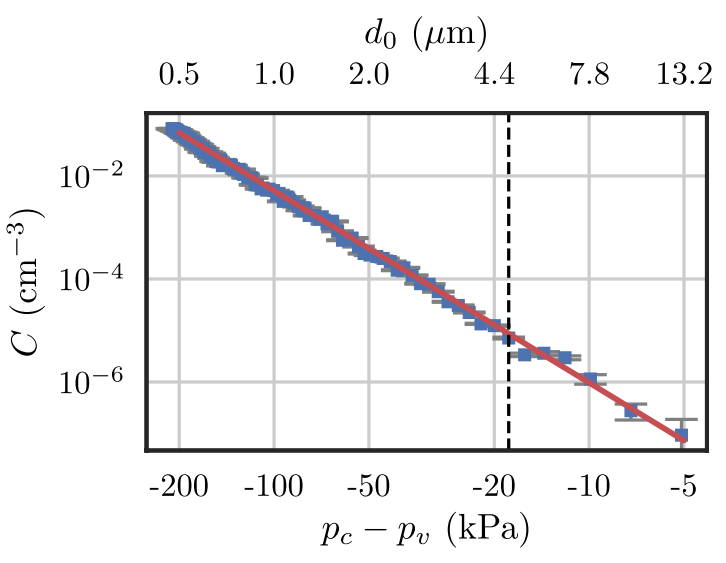 | Venning, J A; Khoo, M T; Pearce, B W; Brandner, P A Background nuclei measurements and implications for cavitation inception in hydrodynamic test facilities Journal Article Experiments in Fluids, 59 (4), 2018, ISSN: 07234864. BibTeX | Links: @article{Venning2018b, title = {Background nuclei measurements and implications for cavitation inception in hydrodynamic test facilities}, author = {J A Venning and M T Khoo and B W Pearce and P A Brandner}, url = {https://jamesvenning.net/wp-content/uploads/2015/11/Venning-et-al.-2018-Background-nuclei-measurements-and-implications-for-cavitation-inception-in-hydrodynamic-test-facilities.pdf}, doi = {10.1007/s00348-018-2520-5}, issn = {07234864}, year = {2018}, date = {2018-01-01}, journal = {Experiments in Fluids}, volume = {59}, number = {4}, publisher = {Springer Berlin Heidelberg}, keywords = {}, pubstate = {published}, tppubtype = {article} } |
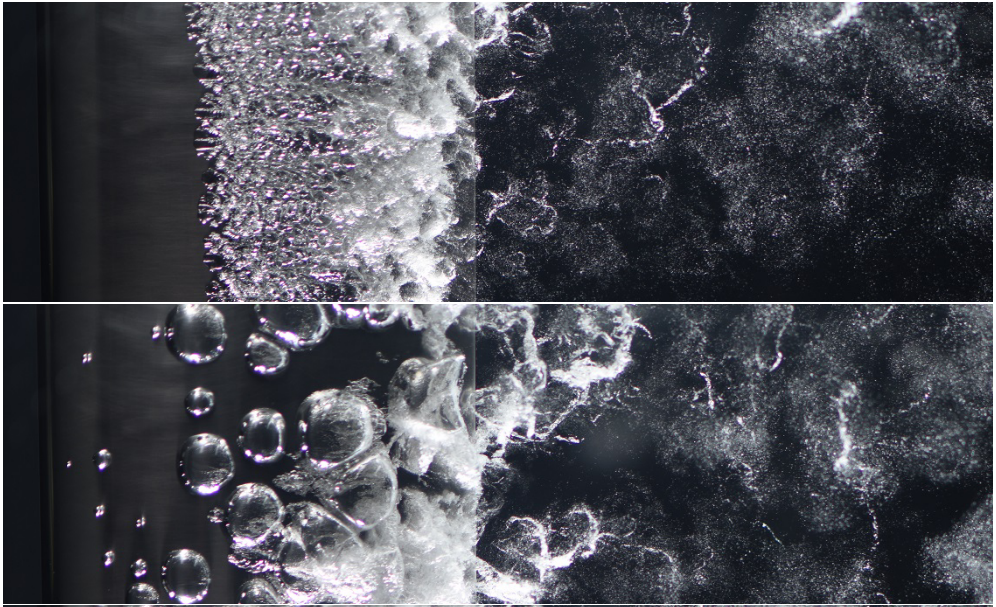 | Russell, P S; Venning, J A; Brandner, P A; Pearce, B W; Giosio, D R; Ceccio, S L Microbubble Disperse Flow about a Lifting Surface Inproceedings 32nd Symposium on Naval Hydrodynamics, 2018. @inproceedings{Russell2018a, title = {Microbubble Disperse Flow about a Lifting Surface}, author = {P S Russell and J A Venning and P A Brandner and B W Pearce and D R Giosio and S L Ceccio}, url = {https://jamesvenning.net/wp-content/uploads/2020/04/2018-SNH-32nd-Russell_et-al.pdf}, year = {2018}, date = {2018-01-01}, booktitle = {32nd Symposium on Naval Hydrodynamics}, number = {August}, abstract = {The effect of freestream nuclei content on stable cavitation about a hydrofoil and subsequent microbubble production in the wake is investigated experimentally. Microbubble concentrations are measured upstream and downstream of the hydrofoil for four upstream nuclei concentrations and three cavitation numbers. For each case the number of activated nuclei on the hydrofoil and the transverse distribution of concentrations in the wake were measured. Upstream nuclei concentrations were measured with interferometric Mie imaging in the size range between 45-250 µm at concentrations up to 30 cm−3 . Wake microbubble concentrations were measured using shadowgraphy in the size range 5-50 µm at concentrations up to 600 cm−3 . Wake concentration were found to increase for small changes in low upstream nuclei concentrations but to then decrease for further increase in concentrations. Wake concentrations were found to generally increase with decrease in cavitation number for a particular upstream nuclei concentration. The increase in wake bubble concentrations with seeding increase, at the high cavitation number, is in the smaller bubble size range whereas the increase at the lower cavitation numbers occurs over a greater size range.}, keywords = {}, pubstate = {published}, tppubtype = {inproceedings} } The effect of freestream nuclei content on stable cavitation about a hydrofoil and subsequent microbubble production in the wake is investigated experimentally. Microbubble concentrations are measured upstream and downstream of the hydrofoil for four upstream nuclei concentrations and three cavitation numbers. For each case the number of activated nuclei on the hydrofoil and the transverse distribution of concentrations in the wake were measured. Upstream nuclei concentrations were measured with interferometric Mie imaging in the size range between 45-250 µm at concentrations up to 30 cm−3 . Wake microbubble concentrations were measured using shadowgraphy in the size range 5-50 µm at concentrations up to 600 cm−3 . Wake concentration were found to increase for small changes in low upstream nuclei concentrations but to then decrease for further increase in concentrations. Wake concentrations were found to generally increase with decrease in cavitation number for a particular upstream nuclei concentration. The increase in wake bubble concentrations with seeding increase, at the high cavitation number, is in the smaller bubble size range whereas the increase at the lower cavitation numbers occurs over a greater size range. |
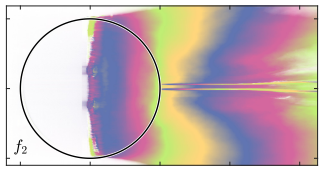 | Venning, James A; Giosio, Dean R; Pearce, Bryce W; Brandner, Paul A Global Mode Visualization in Cavitating Flows Inproceedings Proceedings of the 10th International Symposium on Cavitation (CAV2018), pp. 485–490, 2018. @inproceedings{Vening2018c, title = {Global Mode Visualization in Cavitating Flows}, author = {James A Venning and Dean R Giosio and Bryce W Pearce and Paul A Brandner}, url = {https://jamesvenning.net/wp-content/uploads/2018/06/Venning-et-al.-2018-Global-mode-visualisation-in-cavitating-flows.pdf}, doi = {10.1115/1.861851_ch92}, year = {2018}, date = {2018-01-01}, booktitle = {Proceedings of the 10th International Symposium on Cavitation (CAV2018)}, volume = {2}, number = {X}, pages = {485--490}, abstract = {A technique for visualising global frequency modes and phasing information is presented using fast Fourier transforms applied to individual pixel intensities of high-speed photography image frames. A singular value decomposition is applied to the resulting complex data set to allow the application of windowing to the transforms. A high-speed image set of cloud cavitation about a sphere is used to demonstrate the technique and identify the dominant cavitation shedding modes. Three frequencies were found and the modal analysis show these to correspond to large-scale near symmetric shedding, intermediate-scale oblique shedding, and smallscale near symmetric shedding, respectively. Results obtained by the presented image analysis technique show close agreement to shedding frequencies obtained from pressure data.}, keywords = {}, pubstate = {published}, tppubtype = {inproceedings} } A technique for visualising global frequency modes and phasing information is presented using fast Fourier transforms applied to individual pixel intensities of high-speed photography image frames. A singular value decomposition is applied to the resulting complex data set to allow the application of windowing to the transforms. A high-speed image set of cloud cavitation about a sphere is used to demonstrate the technique and identify the dominant cavitation shedding modes. Three frequencies were found and the modal analysis show these to correspond to large-scale near symmetric shedding, intermediate-scale oblique shedding, and smallscale near symmetric shedding, respectively. Results obtained by the presented image analysis technique show close agreement to shedding frequencies obtained from pressure data. |


